78 Small Flowering Trees (With Pictures): Identification and Growing Guide
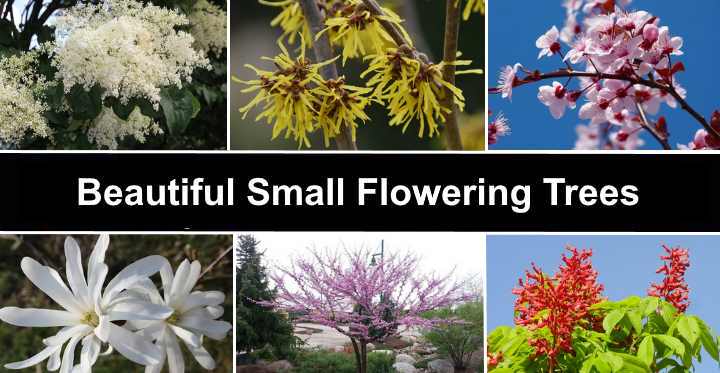
Small flowering trees are ideal for adding color and fragrance to garden landscapes where there’s limited space. Dwarf ornamental trees fill gardens with pink, red, purple, and white colors in spring and summer. Many types of trees for small gardens also provide shade, lush foliage, vibrant, colorful flowers, and attract wildlife.
Small flowering trees are not only for compact landscaping spaces. Dwarf ornamental trees are ideal as lawn trees or growing where tall, expansive trees would be impractical. For example, small deciduous trees, dwarf weeping trees, and miniature flowering trees can grow in most gardens.
Even if you have a patio or paved backyard, fear not – there are plenty of small pink, white, and purple flowering trees that thrive in containers.
This article is a guide to the best types of small flowering trees. Pictures and descriptions of flowering trees will help you identify the best ornamental trees for your front or backyard.
How to Identify Small Flowering Trees
Dwarf or small flowering trees are generally classified as trees that don’t grow taller than 25 ft. (7.6 m). Depending on the limited size of your yard, you may have to look for smaller cultivars or dwarf specimens. To identify small ornamental trees, it’s vital to look at the type of leaves, tree bark, flower type, and when the tree blooms.
Often, you can identify types of small flowering trees by their recognizable colors. For example, compact cherry blossom trees typically have pinkish-white spring flowers. Similarly, dwarf magnolia trees tend to have showy white flowers. However, eastern redbud trees usually only have pink flower clusters in spring.
You can also find flowering trees for small gardens that bloom in summer or winter. Purple crape myrtle trees and some small white magnolias produce flowers in summer. Witch hazel is a small shrub-like tree that grows yellow flowers throughout winter.
If you choose small flowering trees such as tree hydrangeas or tree roses, you can select ornamental trees in various beautiful colors.
Types of Small Flowering Trees with Name and Picture For Easy Identification
Let’s look in more detail at the best examples of small flowering trees for your front yard or backyard. In this list of ornamental trees, tree types are classified by the colors of their blooms.
Types of Small Flowering Trees with Pink Flowers (With Pictures)
Several species of miniature and small trees have various shades of pink blossoms. Some of the most beautiful small flowering trees with pink flowers are cherry trees, red buckeye, and eastern redbuds. These pink blooming small trees grow between 10 and 25. ft (3 – 7.6 m) high.
The height of the tree will also determine how close to your house you can plant the tree. A general guideline is to keep trees at a distance from your home equal to at least half of their height. For instance, if your tree is expected to grow to 20 ft. (6 m), it’s advisable to plant it at least 10 ft. (3 m) away from the building.
Let’s look in more detail at some small trees with pink flowers.
Red Buckeye (Aesculus pavia)
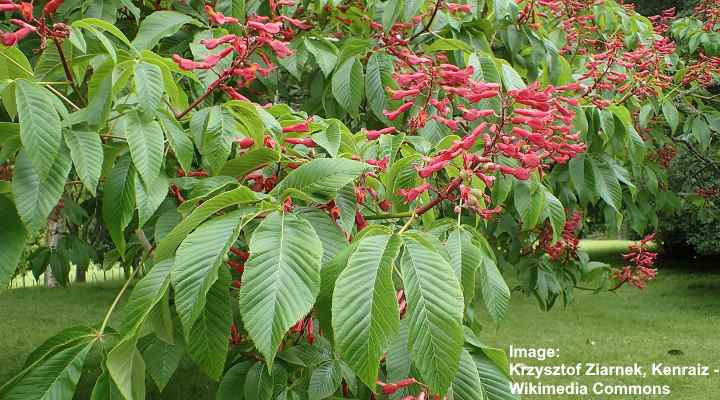
Red Buckeye is a small ornamental tree for front or backyard with reddish-pink flowers
Red buckeye is a small flowering tree with pink-red flowers. The tree grows between 12 and 15 ft. (3.6 – 4.5 m) tall with a rounded canopy up to 15 ft. (4.5 m) wide. Beautiful clusters of reddish-pink flowers adorn the dark green lance-shaped leafy foliage in mid to late spring. Red buckeye is identified by brown fruit or seeds that look like a buck’s eye.
Red buckeye is a slow-growing, compact tree that is ideal for small landscapes. The deep, pink-colored flowers also give the tree common names such as the firecracker plant, scarlet buckeye, and woolly buckeye.
Red buckeye grows best in USDA zones 5 – 9. It thrives in well-drained soil, full sun and is classed as a low-maintenance flowering tree. Grow red buckeye trees as specimen trees or plant them in rows to create a beautiful flowering hedge.
Related reading: How to identify types of buckeye trees.
Mature Size: 12 to 15 ft. (3.6 – 4.5 m) tall and wide
USDA Hardiness Zones: 5 to 9
Sun: Partial shade to full sun
Eastern Redbud (Cercis canadensis)
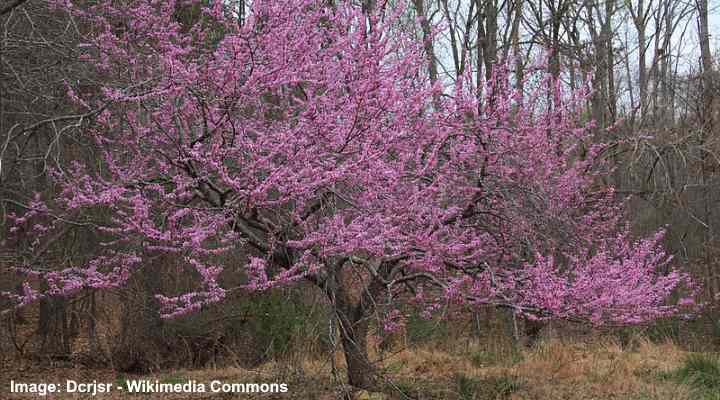
Eastern Redbud is a beautiful flowering tree that will enhance any garden landscape
The eastern redbud is a spectacular small pink-flowering tree. This ornamental tree has delicate rosy-pink flower clusters that bloom before the bright green, heart-shaped leaves emerge in summer. The eastern redbud has dramatic, colorful displays with pink spring flowers and attractive green leaves that turn yellow. Eastern redbuds grow between 20 and 30 ft. (6 – 9 m) tall and up to 35 ft. (10 m) wide.
Small eastern redbud trees are known for their colorful, dark magenta-pink flowers that cover bare branches. As a multi-stemmed tree, eastern redbuds can also grow as a large deciduous flowering shrub. To identify the eastern redbud, look for heart-shaped, broadly ovate leaves, rose-colored spring flowers, and chestnut brown winter buds.
Eastern redbud ornamental flowering trees thrive in USDA zones 4 – 9. Grow in full sun to part shade and make sure the well-draining ground is constantly moist.
Related reading: How to identify varieties of redbud trees.
Mature Size: 20 – 30 ft. (6 – 9 m)
USDA Hardiness Zones: 4 – 9
Sun: Full sun to part shade
Cherry blossom trees (Prunus)
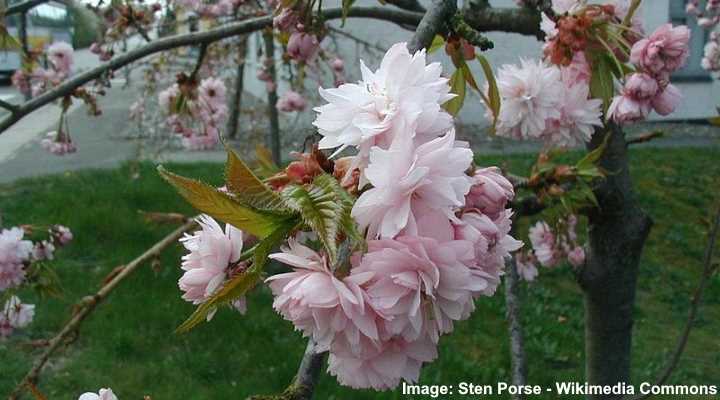
The Japanese dwarf weeping cherry tree features showy ruffled pink flowers and typically reaches a maximum height of 10 ft. (3 m)
Cherry blossom trees are some of the most stunning small trees that produce light pink flowers. Blooming in spring, pink cherry blossoms can be single flowers with five petals or showy double flowers with up to 300 petals. Dwarf ornamental cherry trees grow between 15 and 20 ft. (4.5 – 6 m) tall and wide.
Deciduous cherry blossom trees are identifiable by their spreading habit and vase-shaped, rounded crown. The pink flowers emerge in mid- to late spring and grow in dangling clusters of pinkish-white flowers.
Flowering dwarf weeping cherry trees are perfect for compact garden landscapes. They typically grow between 6 and 15 ft. (1.8 – 4.5 m) tall, and their arching branches create a captivating visual of cascading pink shades, resembling a waterfall of blooms.
These beautiful trees grow best in USDA zones 4 – 9 and thrive in full sun and well-draining, moist soil.
Related reading: How to identify the many types of flowering cherry trees.
Mature Size: 15 – 20 ft. (1.8 – 6 m)
USDA Hardiness Zones: 4 – 9
Sun: Full sun
Types of Small Flowering Trees with White Flowers (With Pictures)
Many species of small flowering trees look magnificent when masses of white flowers cover their branches in spring and summer. Some of the most common white flowering small trees are crabapple trees, hawthorns, and flowering dogwood trees. Many small trees with white flowers grow up to 20 ft. (6 m) tall and wide.
Here is a selection of some beautiful white flowering small trees.
Crabapple Trees (Malus)
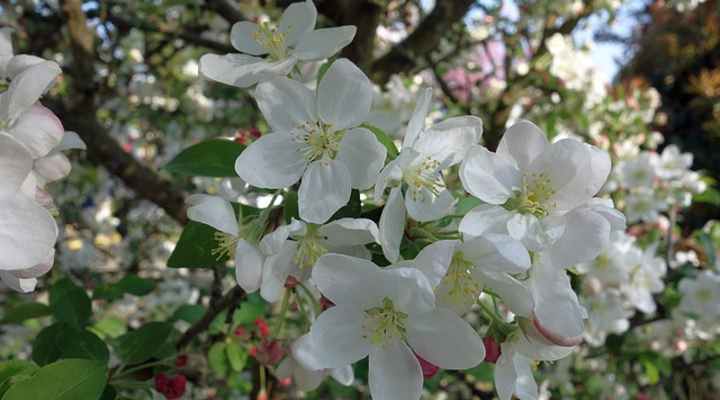
Snowdrift crabapple (Malus ‘Snowdrift’) has white fragrant flowers and grows between 15 and 20 ft. (4.5 – 6 m) tall
Crabapple trees have stunning white spring flowers with five or more oval petals, glossy green, leathery oval leaves, and small apples with a tart flavor. Crabapple trees can grow in most small gardens, as they typically don’t grow taller than 15 ft. (4.5 m). However, the smallest crabapple trees don’t reach more than 5 ft. (1.5 m) tall.
Cold-hardy crabapples with their ornamental white flowers thrive in USDA zones 3 – 8. The best location to grow easy-care crabapple trees is in full sun and moderately fertile, well-draining soil. Crabapples are known for their clusters of tiny, berry-like apples.
Although many crabapple varieties have white flowers, there are also small flowering crabapple trees with red, orange, light pink, and deep purple flowers.
Related reading: Crabapple Trees (Malus): Types, Flowers, Fruits (Pictures).
Mature Size: 5 – 15 ft. (1.5 – 4.5 m)
USDA Hardiness Zones: 3 – 8
Sun: Full sun
Tree Hydrangea (Hydrangea paniculata ‘Grandiflora’)
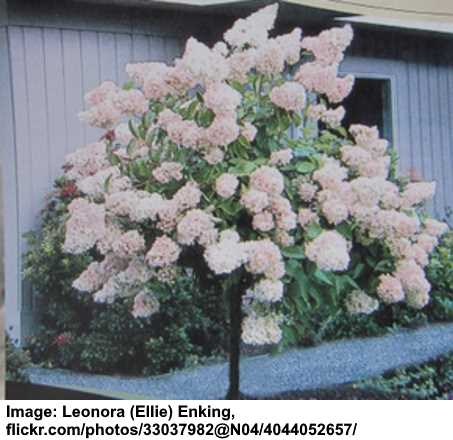
Hydrangea paniculata ‘Grandiflora’ can be trained as a single trunk tree with stunning white flowers
The tree hydrangea is a deciduous, small multi-stemmed landscaping tree renowned for its creamy-white conical flower clusters, dark green leaves, and large rounded crown. The ornamental tree hydrangea blooms throughout the summer and its masses of white flowers cause branches to bend under their weight.
This large hydrangea shrub can also be trained to grow as a single-trunk small tree and is also named ‘PeeGee’ or ‘Grandiflora.’ After blooming in the fall, the large white flowers drop. The tree’s foliage turns reddish-purple in the fall.
The hydrangea ‘Grandiflora’ tree grows up to 25 ft. (7.6 m) tall and thrives in USDA zones 3 – 8. The summer-flowering tree tolerates heat and performs best in full sun and slightly acidic, well-drained soil. Tree hydrangeas grow best as a specimen tree, a flowering privacy screen, or in mixed shrub borders.
Mature Size: Up to 25 ft. (7.6 m)
USDA Hardiness Zones: 3 – 8
Sun: Full sun
Flowering Dogwood (Cornus)
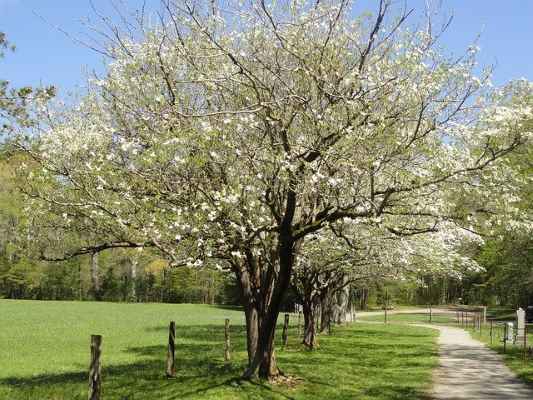
Flowering dogwood trees add decorative touch to any garden with their white flowers
Fast-growing dogwood trees are early spring bloomers with white, oval, four-petaled flowers. Green, ovate, pointed leaves cover trees in the summer before turning reddish-purple in the fall, and clusters of red, berry-like drupes appear in the fall. Small deciduous dogwood trees grow between 15 and 25 ft. (4.5 – 7.6 m) tall.
Some species of small flowering dogwood trees have clusters of tiny white flowers growing in oval clusters.
White-flowering dogwood trees grow best in USDA zones 3 – 8. The trees thrive in full sun to part shade and need to grow in rich, well-draining ground.
Related reading: How to identify the most common dogwood trees.
Mature Size: 15 – 25 ft. (4.5 – 7.6 m)
USDA Hardiness Zones: 3 – 8
Sun: Full sun to part shade
English Hawthorn (Crataegus laevigata)
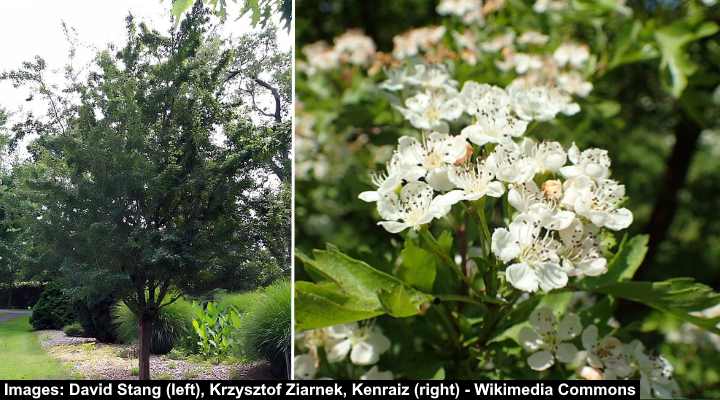
The English hawthorn is a small deciduous tree known for its clusters of pretty white flowers that bloom in the spring, releasing a sweet fragrance. These delicate blossoms have small oval petals and pale-yellow stamens. Against the backdrop of the tree’s deep green foliage, the vibrant white flowers create a striking visual display. This small ornamental tree stands out with its glossy green leaves, large thorns, attractive red fruits in the autumn, and branches that zig-zag in interesting patterns.
English hawthorn trees are hardy and adaptable, thriving in different soil types such as clay, loam, and sandy soils. They serve well as security hedges or can be used as standout specimen trees in the garden. Their ability to withstand salty air makes them an excellent choice for coastal landscapes and wildlife-friendly gardens.
Related reading: How to identify species of hawthorn trees.
Mature Size: 15 to 20 ft. (4.5 – 6 m) tall and wide
USDA Hardiness Zones: 5 to 8
Sun: Full sun
Star Magnolia (Magnolia stellata)
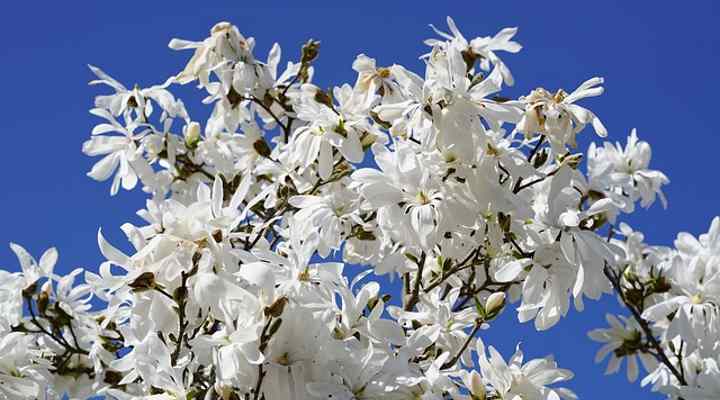
The small flowering Star Magnolia is a deciduous tree with white, star-shaped flowers
The star magnolia is a species of beautiful small trees with attractive star-shaped, fragrant white flowers and leathery green leaves that turn yellow in the fall. Hardy magnolia trees are early spring bloomers, and the brilliant white flowers appear on leafless branches. Star magnolia trees grow between 5 and 8 ft. (1.5 – 2.4 m) tall.
The common name, star magnolia, comes from the appearance of the tree’s white flowers. Oblong white petals fan out like rays, creating flowers in the shape of a star.
Ornamental small star magnolia trees thrive in USDA zones 4 – 9. The hardy trees grow best in full sun and organically rich, well-draining soil. Most people grow star magnolias as specimen plants in garden landscapes. Depending on the climate, magnolias are deciduous or evergreen trees.
Related reading: How to identify magnolia trees and shrubs.
Mature Size: 5 – 8 ft. (1.5 – 2.4 m)
USDA Hardiness Zones: 4 – 9
Sun: Full sun
Fringe Tree (Chionanthus virginicus)

The small deciduous and hardy fringe tree has white scented flowers
The fringe tree is a low-maintenance, multi-stemmed, small deciduous tree with fragrant white flowers and wiry white petals. Fringe trees bloom in late spring when the fuzzy-looking, creamy-white flowers cover the tree’s green foliage. When the petals drop in late summer, they look like a snow blanket covering the ground. Fringe trees grow between 10 and 20 ft. (3 – 6 m) tall.
Fringe trees provide plenty of year-long interest. The lance-shaped green leaves on these small trees offer summer shade. Beautiful snow-white flowers adorn the tree in spring and summer. And the gray-brown furrowed bark provides winter interest.
The fringe tree grows best as a specimen tree or in mixed borders in USDA zones 3 – 9. Make sure to grow this tree in well-draining, moist soil.
Mature Size: 10 – 20 ft. (3 – 6 m)
USDA Hardiness Zones: 3 – 9
Sun: Full sun
Flowering Japanese Lilac Tree (Syringa reticulata)
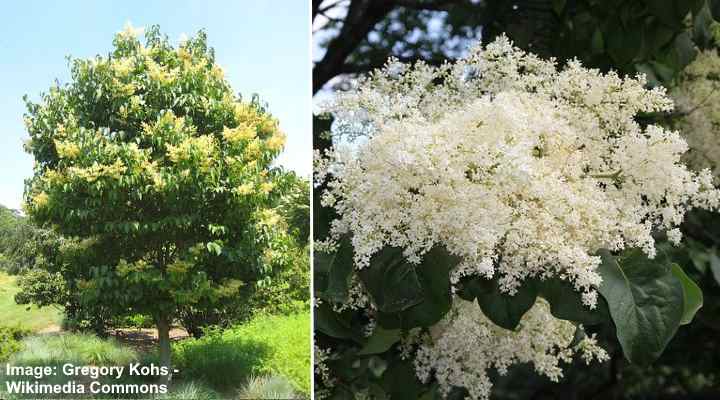
Japanese lilac is a great front of house small tree with large clusters of white flowers
The Japanese lilac tree is a white-flowering shrub-like tree with enormous conical clusters of creamy-white flowers, dark green, ovate leaves, and a rounded crown. Early summer blooms on tree lilac plants are short-lived and last for two weeks. After flowering, tan seed pods persist on the tree until winter, and the copper-colored bark provides winter interest.
The Japanese lilac tree grows around 20 ft. (6 m) tall and wide as an attractive landscape tree.
The Japanese tree lilac grows best in full sun or partial shade. To prevent disease, ensure there is plenty of air circulation and that the shrubby lilac tree grows in well-draining soil.
Mature Size: Around 20 ft. (6 m)
USDA Hardiness Zones: 3 – 7
Sun: Full sun to partial shade
Types of Small Flowering Trees with Purple Flowers (With Pictures)
Small trees with purple flowers provide plenty of color in garden landscapes. Some types of ornamental dwarf trees have flowers in various lilac, lavender, purple, and mauve shades. Generally, small trees with purple flowers grow between 4 and 20 ft. (1.2 – 6 m).
Saucer Magnolia (Magnolia x soulangeana)

Saucer magnolia grows between 15 and 20 ft. (4.5 – 6 m) tall and has large flowers that come in shades of pink, purple and white
The saucer magnolia is one of the most popular deciduous small magnolia trees. The small saucer magnolia tree gets its common name from the huge, light purple-pink saucer-like tulip flowers. As an early bloomer, the purple magnolia flowers appear on bare branches in spring, creating a dramatic floral display.
In mid-spring, large leathery, dark green oval leaves create dense shade foliage on the saucer magnolia. The attractive rounded crown makes an eye-catching garden feature until fall when the leaves drop. In warmer climates, saucer magnolia trees are evergreen.
Saucer magnolias grow best in USDA zones 6 – 9. Plant the small landscaping trees in full sun and keep the ground moist for best results.
Mature Size: 20 – 25 ft. (6 – 7.6 m)
USDA Hardiness Zones: 6 – 9
Sun: Full sun
Crape Myrtle (Lagerstroemia indica)
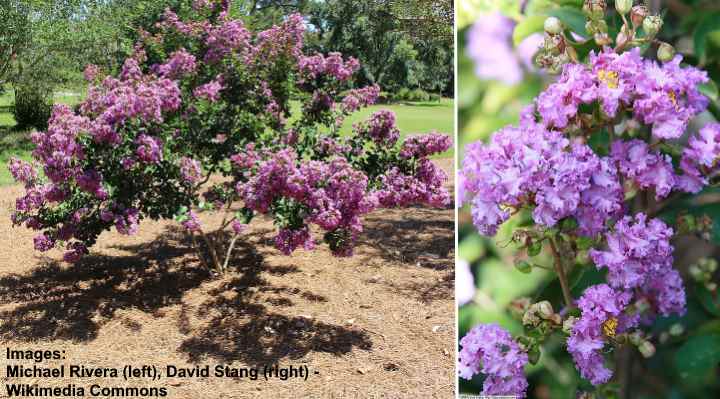
Catawba Crape Myrtle (Lagerstroemia indica ‘Catawba’) is a stunning example of small tree that grows between 10 and 15 ft. (3 – 4.5 m) tall and has purple flowers
Dwarf crape myrtle trees are large deciduous shrubs that are trained to grow as specimen trees. Many species of small ornamental crape myrtle trees have clusters of bright purple flowers that bloom from spring until fall. The stunning purple flowers contrast with the green foliage, made up of small, ovate green leaves that turn golden yellow in the fall.
Many crape myrtle shrubs grow as beautiful miniature ornamental trees. The showy clusters of purple, pink, red, and white flowers provide plenty of color in landscapes throughout the summer.
Small crape myrtle ornamental trees thrive in well-draining soils with a loamy or clay texture in USDA zones 6 – 10. You can grow the small trees as patio plants in containers, specimen lawn trees, or foundation plantings. Kept as shrubs, crape myrtles also make beautiful informal hedges.
Related reading: How to identify crape myrtle trees and shrubs.
Mature Size: 20 – 25 ft. (6 – 7.6 m)
USDA Hardiness Zones: 6 – 10
Sun: Full sun
Chaste Tree (Vitex agnus-castus)
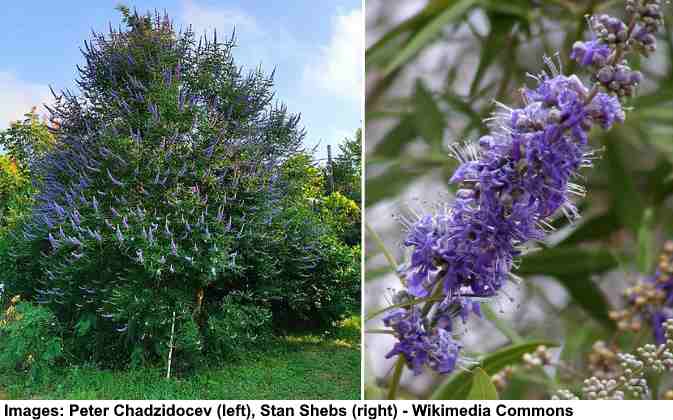
The chaste tree, a small tree or shrub, is characterized by its beautiful, spiky clusters of sweet-scented purple flowers. The tree’s vase-shaped canopy is adorned with lilac or pale blue flowers, creating an attractive sight during the summer. After the flowers have faded, small, peppercorn-like black fruits form.
The tree is also called the monk’s pepper or the lilac chaste tree.
The chaste tree has a tropical look due to its aromatic dark green palmate leaves. The leaves are divided into five to seven leaflets, displaying silvery undersides that shimmer in the breeze. With its abundant leaves and long-lasting flowers, this compact, ornamental tree adds considerable charm to any outdoor setting.
Chaste trees are ideal for different landscaping uses, including shrub borders, foundation plantings, or as individual focal points. They are resistant to most pests and diseases once established. During the summer season, the purple flowers emit a pleasant fragrance that draws butterflies and other pollinators.
Related reading: How to identify chaste trees.
Mature Size: 4 to 15 ft. (1.2 – 4.5 m) tall and wide
USDA Hardiness Zones: 6 to 9
Sun: Full sun
Other Types of Small Flowering Trees (With Pictures)
Let’s look in more detail at other types of small flowering trees with unusual flowers and attractive growth.
Witch Hazel (Hamamelis)
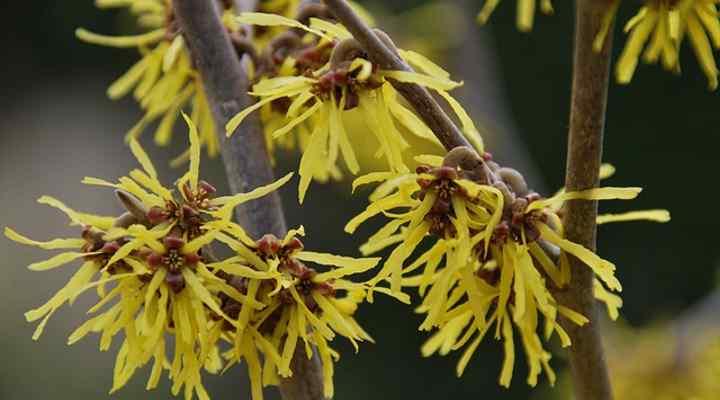
Witch hazel species are cold tolerant small shrubby trees that provide cheerful yellow winter blooms
Witch hazel is a small winter-flowering tree or shrub with fascinating yellow flowers made up of spidery petals. The blooming time for witch hazel is between October and February, when the yellow flowers decorate woody, leafless stems. During summer, attractive oval green leaves cover the tree before turning yellow and dropping.
Decorative witch hazel trees mature at around 20 ft. (6 m), and they can be up to 20 ft. (6 m) wide. As a cold-hardy small tree, witch hazels thrive in USDA zones 3 – 9. Grow this tree in well-draining, loamy or clay soil.
Mature Size: Up to 20 ft. (6 m)
USDA Hardiness Zones: 3 – 9
Sun: Full sun to partial shade
Golden Chain Tree (Laburnum x watereri)
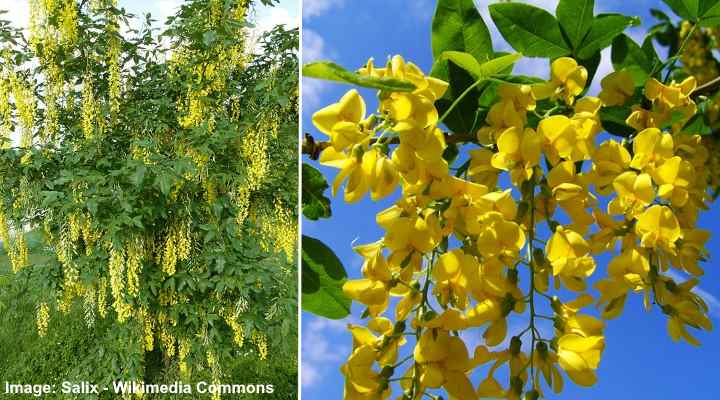
Golden Chain Tree grows 12 – 15 ft. (3.6 – 4.5 m) tall and has long clusters of yellow flowers
The golden chain tree is an eye-catching small tree that has drooping clusters of small pea-like yellow flowers. In late spring, when in full bloom, the golden chain tree looks as if yellow chains are cascading from the branches. The beautiful yellow flower clusters can grow up to 2 ft. (60 cm) long.
Golden chain tree thrives in USDA zones 6 – 8. The best way to grow these deciduous trees is as a specimen tree or over arbors or pergolas in organically rich, well-drained soil.
Mature Size: 12 – 15 ft. (3.6 – 4.5 m)
USDA Hardiness Zones: 6 – 8
Sun: Full sun to partial shade
Red Powder Puff Tree (Calliandra haematocephala)
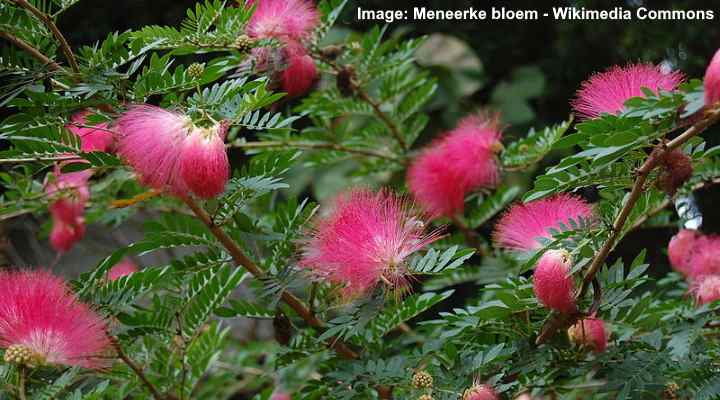
The small red powder puff tree has unusual-looking fuzzy flowers that come in shades of red, pink, or white
Red powder puff trees are large, heat-loving shrubs that are trained to grow on a single trunk. The small flowering red powder puff trees have a spreading vase shape and are covered in soft fuzzy bright red, pink, or white flowers. The unusual tree flowers look like fan-shaped brushes dipped in colorful paint.
Powder puff trees grow rapidly, reaching a mature height of 10 to 15 ft. (3 – 4.5 m). These trees thrive in well-draining soil and are best suited for USDA hardiness zones 9 to 11.
The best way to grow powderpuff trees in your sunny garden is as a corner-of-house accent, lawn tree, along driveways, or as a patio shade tree.
Mature Size: 10 – 15 ft. (3 – 4.5 m)
USDA Hardiness Zones: 9 – 11
Sun: Full sun
Plumeria Tree (Frangipani)
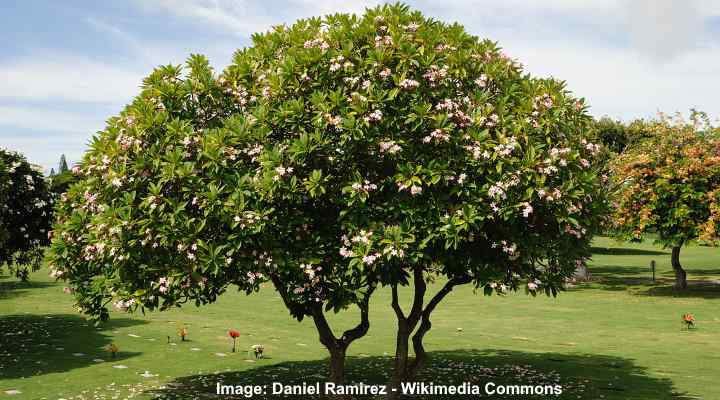
Plumeria tree
Plumeria is a group of small flowering trees or shrubs and is famous for highly scented, exotic, showy flowers. Plumeria flowers are shaped like stars and come in shades of white, yellow, pink, red, and multi-colors.
Plumeria trees are also called frangipani. These tropical trees are classed as deciduous or semi-evergreen trees or shrubs. However, there are a few evergreen plumeria tree species, like the Plumeria obtusa and Plumeria pudica. The spectacular flowering trees thrive in USDA zones 9 through 12. These flowering trees commonly grow in Florida, the Caribbean, the Pacific islands, Mexico, and Central America.
Frangipani trees are moderately fast-growing plants that can grow up to 20 ft. (6 m) tall. However, in most tropical and subtropical garden landscapes, the exotic trees reach between 6 and 8 ft. (1.8 – 2.4 m) tall.
The only care plumeria trees require is plenty of sunlight, well-drained soil, water, and fertilizer.
Further reading: Plumeria Tree: Growing and Care Guide.
Mature Size: 6 – 8 ft. (1.8 – 2.4 m)
USDA Hardiness Zones: 9 – 12
Sun: Full sun
Purple Leaf Plum Tree (Prunus cerasifera)
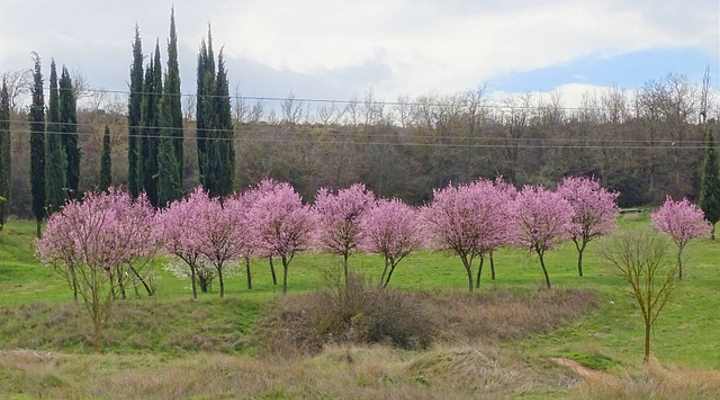
Purple Leaf Plum
The purple leaf plum tree (Prunus cerasifera) is a small ornamental flowering tree with fragrant whitish-pink spring flowers and dark burgundy or purple leaves. Each attractive, fragrant flower has five petals growing in a radial form measuring 1″ (2.5 cm) across.
The small flowering purple-leaved plum tree grows between 15 and 25 ft. (4.5 – 8 m) tall. The deciduous tree has dense foliage and a vase-shaped crown.
Also called the cherry plum tree, the purple leaf plum is an easy-to-grow ornamental tree that grows best in moist but well-drained soil that is moderately fertile. The attractive dark foliage tree performs well in full sun and can tolerate some shade. However, too much shade causes the leaves to turn green.
The purple leaf plum tree also produces small, plum-like yellow or red edible fruit.
Mature Size: 15 – 25 ft. (4.5 – 8 m)
USDA Hardiness Zones: 4 – 8
Sun: Full sun
Texas Redbud Tree (Cercis canadensis var. texensis)

Texas Redbud (Cercis canadensis var. texensis)
The Texas redbud tree is a beautiful small ornamental tree admired for its clusters of magenta-purple flowers. In early spring, these pea-sized flowers burst into vibrant color, covering the branches before the leaves emerge. As the leaves grow, the pink-purple flowers continue to bloom, enhancing the tree’s beauty.
The Texas redbud tree is easily identifiable by its heart-shaped leaves and plentiful purple, pink, or deep reddish-purple blooms. The tree also has dark green foliage that turns a pleasant yellow in the fall. This versatile tree can thrive in different soil types, including clay, loam, and sandy soils.
Perfect for small to medium-sized landscapes, this native Texas tree brings charm as an ornamental addition, adding a vibrant touch to urban gardens or creating a delightful flowering border. Its stunning flowers provide a vivid display of color during the early spring season.
Mature Size: 12 to 18 ft. (3.6 – 5.5 m) tall and 10 to 15 ft. (3 – 4.5 m) wide
USDA Hardiness Zones: 6 to 9
Sun: Full sun or partial shade
Japanese Flowering Quince (Chaenomeles Japonica)
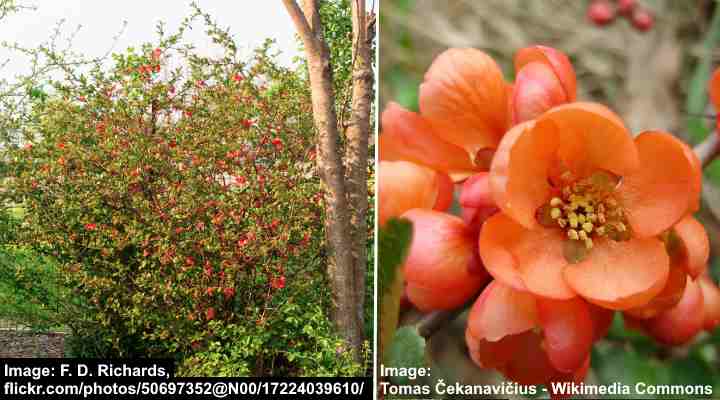
The Japanese flowering quince is a small deciduous shrub characterized by its charming orange-scarlet flowers. This compact plant can even be grown as a dwarf ornamental tree. In early spring, the orange cup-shaped flowers appear in clusters before the leaves grow on their branches. Once the orange blossoms fade away, small, tangy yellowish fruits take their place.
Perfect for landscaping, it can serve as a low-flowering hedge, a shrub border plant, or be grown in a container. The shrub’s spiny branches, adorned with sharp thorns, make it an excellent choice for foundation plantings or as a security screen around a backyard.
Mature Size: 2 to 3 ft. (0.6 – 1 m) tall and 3 to 6 ft. (1 – 1.8 m) wide
USDA Hardiness Zones: 5 to 9
Sun: Full sun to partial sun
Burgundy Desert Willow (Chilopsis linearis ‘Burgundy’)

The burgundy desert willow is easily identified by its attractive, trumpet-shaped flowers, which range in color from burgundy-pink to purple. These vibrant flowers grace the tree in late spring and early summer, adding a stunning burst of color. This tree’s nectar-rich blooms attract hummingbirds and butterflies, adding to the tree’s allure.
With its long, slender leaves resembling those of a willow and airy foliage that complements the purplish-pink flowers, this tree creates a captivating display in sunny landscapes. The versatility of this purple-flowering tree allows for planting in xeriscape gardens, desert gardens, or wildlife gardens, where it serves as an accent tree or aids in erosion control.
The burgundy desert willow catches attention with its distinctive colors and ability to withstand drought, heat, and full sun exposure. Additionally, it shows resistance to most pests and diseases, making it a low-maintenance choice for your garden.
Mature Size: 15 to 20 ft. (4.5 – 6 m) tall and wide
USDA Hardiness Zones: 7 to 9
Sun: Full sun
Purple Glory Tree (Tibouchina granulosa)
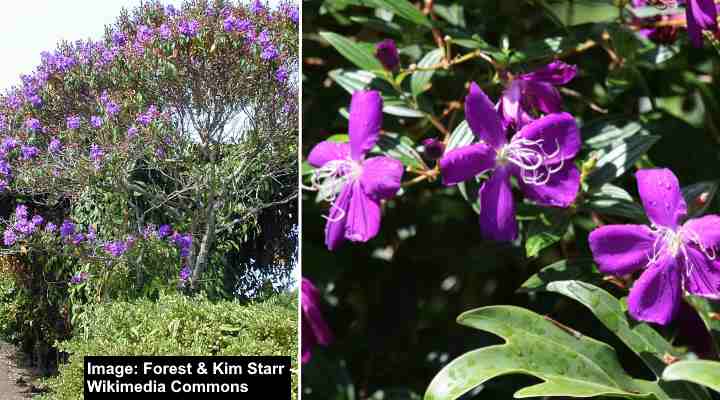
The purple glory is an attractive small tropical tree that enhances any garden with its lovely violet-purple flowers. These captivating flowers cover the tree’s canopy, providing a year-round display of vibrant colors. The sizable blossoms have a velvety texture that complements the glossy, dark green lanceolate leaves.
This small purple flowering tree flourishes in warm, tropical climates and prefers well-drained, moist soil enriched with organic matter. In hotter regions, some shade from the intense afternoon sun is needed.
Its versatility allows it to be grown as a specimen tree, trained against a wall like an espalier, or allowed to climb over a trellis or arbor similar to a vine. Due to its adaptability, it’s an ideal option for mixed shrub borders or container gardening.
Mature Size: 15 to 20 ft. (4.5 – 6 m) tall and wide
USDA Hardiness Zones: 10 and 11
Sun: Full sun to partial shade
Common Smoke tree (Cotinus coggygria)
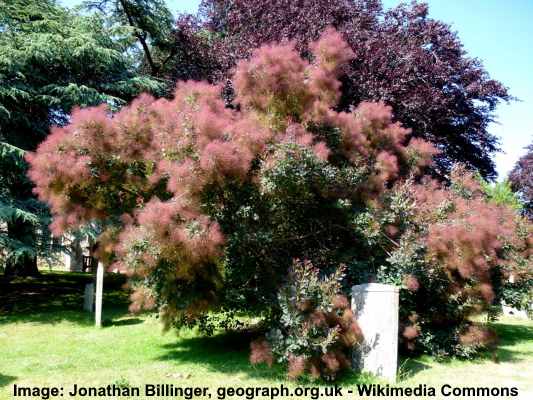
smoke tree in landscape
The common smoke tree is a beautiful deciduous tree often grown as an ornamental tree due to its decorative appeal. It showcases charming clusters of purple-pink flowers. These flowers are distinct, with delicate threads that give them a soft, smoky appearance. In autumn, the tree’s leaves change from purple to red, yellow, or orange.
Some types of smoke trees can handle colder climates. For vibrant foliage, these trees prefer plenty of sunlight but can also tolerate partial shade.
You can plant smoke trees as flowering hedges, screens, or eye-catching specimen trees, adding visual interest to your landscape.
While the ornamental plant has a relatively short lifespan of about 20 years, most gardeners would agree that the beauty it brings to a garden makes it well worth it.
Mature Size: 10 to 15 ft. (3 – 4.5 m) tall and wide
USDA Hardiness Zones: 4 to 8
Sun: Full sun or partial shade
Tea Plant (Camellia sinensis)

The tea plant is an evergreen shrub or small tree that is known for its attractive, delicate white flowers and fragrant tea leaves. While the flowers are not widely recognized, they are small and beautiful with yellow centers. The glossy green foliage and fragrant white blooms make tea plants a wonderful addition to shaded areas in your garden, adding an elegant touch to the landscape.
Tea plants thrive in acidic, well-drained, and consistently moist soils, making them well-suited for moderate climates. They can be grown in containers or directly in the ground, offering versatility in cultivation. Apart from their visual appeal, tea plants also have the added benefit of their leaves being suitable for making types of tea.
Mature Size: 10 to 15 ft. (3 – 4.5 m) tall and 6 to 10 ft. (1.8 – 3 m) wide
USDA Hardiness Zones: 7 to 9
Sun: Partial shade
American Elderberry (Sambucus canadensis)

The American elderberry, a deciduous shrub or small tree, is known for its delicate clusters of small, sweet-smelling white flowers that bloom in the spring. These flower clusters present a delightful contrast against the lush, lance-shaped green leaves. As the flowering season ends, glossy black berries appear in clusters, ready to be enjoyed as a tasty treat.
Native to North America, elderberries flourish in areas such as wetlands, stream banks, and open woodlands. This hardy shrub can be shaped into a tree or left to grow freely, making it an ideal choice for creating a relaxed screen or hedge. Not only do the fragrant white flowers attract pollinators, but the berries also serve as a magnet for various birds and wildlife, adding to the charm of your garden.
Mature Size: 5 to 12 ft. (1.5 – 3.7 m) tall and wide
USDA Hardiness Zones: 3 to 9
Sun: Full sun to partial shade
Texas Mountain Laurel Tree (Sophora secundiflora)

The Texas mountain laurel is a purple flowering tree native to Texas that is suitable for full sun or partial shade
The Texas mountain laurel is a small evergreen tree known for its clusters of fragrant pale purple flowers. These flowers resemble grape hyacinths and bloom in late winter or early spring, displaying their purple-lavender hues. Hanging in drooping clusters that measure 3 to 7 inches (7.5 – 18 cm) long, they attract bees and butterflies, adding to the garden’s beauty.
Being a native tree of North America, the Texas mountain laurel has leathery dark green leaves that create dense foliage, with palmate leaves featuring oval leaflets. This tree is well-suited to drought conditions and thrives in soil that drains well.
The Texas mountain laurel is an excellent choice for xeriscape gardens or as an eye-catching focal point in small landscapes. Its lovely purple flowers and evergreen foliage enhance the beauty of any garden setting.
Mature Size: 10 to 15 ft. (3 – 4.5 m) tall and 8 to 15 ft. (2.5 – 4.5 m) wide
USDA Hardiness Zones: 7 to 11
Sun: Full sun to partial shade
White Flowering Almond Tree (Prunus glandulosa alboplena)
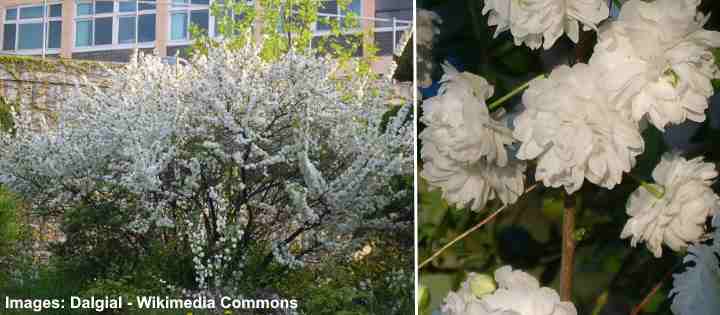
The white flowering almond tree is well-known for its dainty white blossoms that grace the early spring landscape. These exquisite flowers have a gentle, cloud-like appearance, creating a charming sight. After the blooming period, the tree covers its branches with vibrant green leaves, making it an eye-catching feature throughout the year and providing a lush backdrop for its captivating flowers.
The versatility of the white flowering almond tree makes it a perfect choice for various garden designs. Whether you use it as a striking focal point, a lovely border tree, or group several together for a breathtaking visual impact, this tree will add beauty to your garden in many ways.
Mature Size: 6 to 8 ft. (1.8 – 2.4 m)
USDA Hardiness Zones: 4 to 8
Sun: Full sun
Western Redbud (Cercis occidentalis)
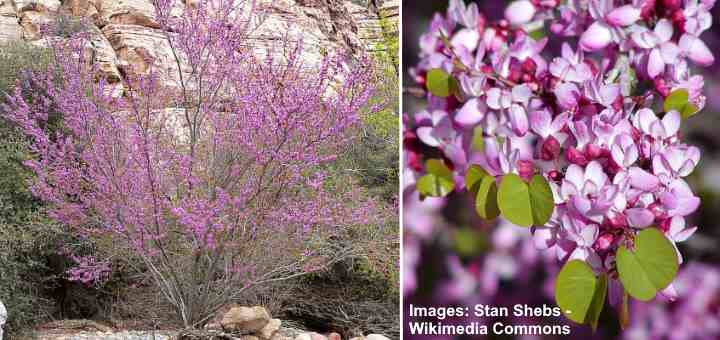
The California-native western redbud is a small deciduous tree known for its beautiful pink flowers, open, rounded shape, and heart-shaped leaves. In early spring, before the leaves emerge, the tree showcases a spectacular display of pink flowers, creating a mesmerizing sight. As fall approaches, the foliage changes to shades of golden yellow or rusty red.
Western redbud trees add beauty to residential gardens throughout the year. After the pink flowers bloom, long purple-brown seed pods appear. During winter, the tree’s compact and irregular branching pattern adds to its beauty. Thanks to their small size and multi-trunked growth, western redbuds are a great choice as specimen trees for gardens with limited space.
Thriving in various soil types, western redbud trees become drought-tolerant once they are established. They require relatively low maintenance, making them a practical choice for garden enthusiasts.
Mature Size: 10 to 15 ft. (3 – 4.5 m) tall and wide
USDA Hardiness Zones: 6 to 9
Sun: Full sun to partial shade
Black Lily Magnolia (Magnolia liliiflora ‘Nigra’)
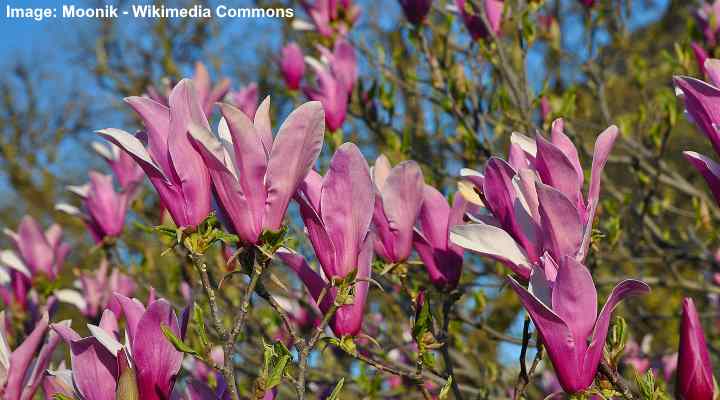
The small black lily magnolia tree has deep pink, tulip-shaped flowers
The black lily magnolia is a delightful small tree known for its striking lily-like flowers that come in shades of dark pink to purple. These fragrant pink blooms emerge in late spring and continue to grace the tree with sporadic beauty throughout the summer, bringing bursts of color to the surroundings. Against the backdrop of glossy, dark green leaves, the vibrant flowers create a captivating visual display, with some growing up to 5″ (12 cm) in length.
Due to their compact size, black lily magnolias are a wonderful choice for small front or backyards. Whether planted in cottage gardens, city gardens, or used as a focal point on a lawn, these trees infuse their surroundings with beauty and charm. They thrive best in well-drained, slightly acidic soils, ensuring optimal growth and blooming for a delightful garden experience.
Mature Size: 8 to 12 ft. (2.4 – 3.6 m) tall and wide
USDA Hardiness Zones: 5 to 9
Sun: Full sun to partial sun
Princess Flower Tree (Tibouchina urvilleana)
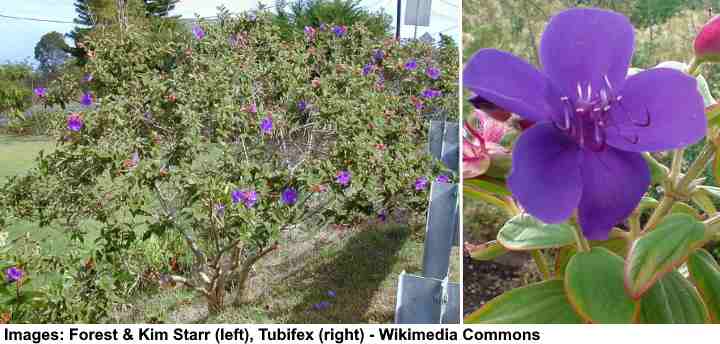
The princess flower is a tropical evergreen shrub or small tree that will enhance the beauty of your garden with captivating purple flowers. These large, five-petaled, velvety blooms are a vibrant shade of purple. During late summer and early fall, the plant transforms into a magnificent spectacle of color, adorned with these attractive flowers.
The princess flower showcases glossy dark green leaves, adorned with prominent longitudinal veins and delicate wiry stamens.
When grown as a small tree, the princess flower becomes a beautiful focal point near a patio or lawn. As a shrub, you can use princess flower trees to create borders, edging, container gardens, or foundation plantings, while simultaneously inviting butterflies to your garden.
Mature Size: 10 to 20 ft. (3 – 6 m) tall and 6 to 10 ft. (1.8 – 3 m) wide
USDA Hardiness Zones: 9 to 11
Sun: Full sun to partial shade
Pink Peacock Flower (Caesalpinia pulcherrima ‘Rosea’)

The pink peacock flower is a delightful small ornamental tree adorned with clusters of stunning pink-reddish flowers. These flowers have an exotic and distinctive look, with long, slender stamens emerging from their bowl-shaped blossoms. The tree’s foliage is equally impressive, featuring attractive fern-like leaves that create a beautiful contrast alongside its brown seed pods.
Due to its compact size, the pink peacock tree is an excellent choice for smaller gardens or as an accent tree in larger yards. Its branches, covered with spines, offer a practical security solution when used as a hedge, privacy screen, or foundation planting. The vibrant pink flowers of the tree make it a sought-after option for adding a splash of color and visual interest to any garden setting.
Mature Size: 10 to 15 ft. (3 – 4.5 m) tall and 6 to 12 ft. (1.8 – 3.6 m) wide
USDA Hardiness Zones: 9 to 11
Sun: Full sun
Chinese Plum Tree (Prunus glandulosa)
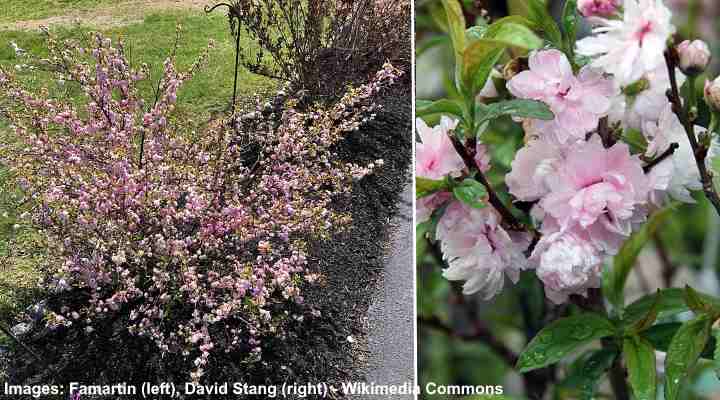
The Chinese plum tree, also known as the flowering almond, is a charming compact ornamental shrub or small tree famous for its beautiful pink blossoms. This deciduous tree creates clusters of pinkish-white flowers, putting on a delightful display. The cherry-like double flowers emerge in early spring before the leaves, adorning the tree with an exquisite array of pink blooms. As autumn arrives, the oval green leaves of the tree transform into a modest yellow hue.
Cultivating Chinese plum trees is of minimal effort, as they adapt well to various soil types, as long as proper drainage is ensured. A popular choice as an ornamental tree, the dwarf flowering Chinese plum tree adds captivating beauty to front or backyards, becoming a focal point that enhances the allure and fragrance of any landscape.
Mature Size: 4 to 5 ft. (1.2 – 1.5 m) tall and wide
USDA Hardiness Zones: 4 to 8
Sun: Full sun to partial shade
Pineapple Broom Tree (Cytisus battandieri)
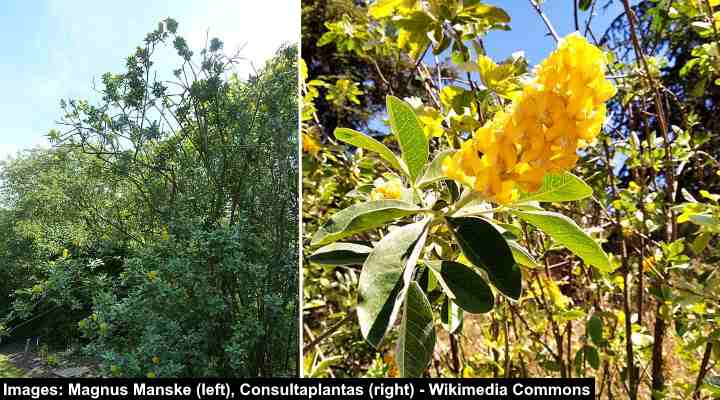
The pineapple broom tree is known for its dense clusters of bright yellow, pea-like flowers. These delightful flowers bloom on upright cylindrical spikes, releasing a delightful pineapple-like fragrance. From late spring until summer, this ornamental tree brings vibrant green and yellow hues to backyards, creating a colorful atmosphere.
Also known as the Moroccan broom tree, it features gray-green, needle-like leaves that add an intriguing texture to the landscape. Pineapple broom trees are adaptable to drought conditions and can thrive even in poor soil. You can incorporate this yellow-flowering tree into your garden as an accent plant, a stunning flowering specimen tree, or a strategic choice to attract pollinators and wildlife, making it a valuable addition to any garden setting.
Mature Size: Up to 13 ft. (4 m) tall and wide
USDA Hardiness Zones: 7 to 10
Sun: Full sun
Mexican Bird of Paradise (Caesalpinia mexicana)

The Mexican bird of paradise is a charming small tree that bursts with beauty during summer and fall, showcasing lavish clusters of bright yellow flowers. These attractive flowers elegantly dangle in showy racemes, measuring about 6 inches (15 cm) long. As the blooming season comes to an end, large, curled seed pods become visible. In regions without frost, this ornamental tree retains its evergreen bipinnate leaves.
Mexican bird of paradise trees are highly sought-after for their appealing fern-like foliage and striking yellow flowers. With its rapid growth and shrub-like appearance, it serves as an excellent accent plant or flowering tree. Its vibrant display of yellow blooms is sure to captivate garden enthusiasts throughout the blooming season.
Mature Size: 10 to 15 ft. (3 – 4.5 m) tall and wide
USDA Hardiness Zones: 9 to 11
Sun: Full sun
Yellow Silk Cotton Tree (Cochlospermum religiosum)
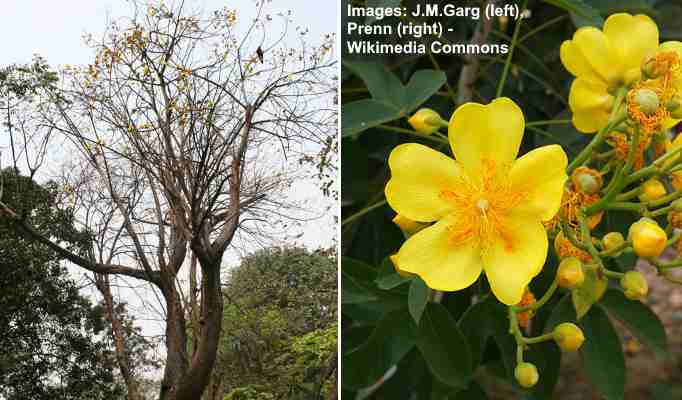
The yellow silk cotton tree is a small, tropical tree admired for its stunning buttercup yellow flowers. These large, showy flowers create a beautiful display, making the tree a delightful sight during the spring and summer months. The tree also produces seeds enclosed in a fluffy, cotton-like substance.
Also known as the buttercup tree, the yellow silk cotton tree serves well as both an accent plant and an ornamental tree in xeriscapes. Its spreading canopy also provides excellent shade. This tree will undoubtedly add a splash of beauty to your outdoor space.
Mature Size: Up to 25 ft. (7.5 m) tall and wide
USDA Hardiness Zones: 9 to 11
Sun: Full sun
Goldenball Leadtree (Leucaena retusa)

Goldenball Leadtree (Leucaena retusa)
The goldenball leadtree is a delightful small tree, known for its clusters of attractive golden-yellow powder-puff flowers. When spring and fall arrive, this tree covers itself with fluffy yellow blooms, proudly displaying its feathered compound leaves and long brown seed pods, each measuring about 6 inches (15 cm). The leadtree bursts into a magnificent array of golden-yellow hues after rainfall.
These small captivating trees with their yellow flowers have arching and drooping stems, making them a delightful addition to any backyard garden. Native to the United States and northern Mexico, it is especially well-suited for southern gardens. In addition, these trees are drought-, heat-, and salt-, tolerant, which helps ensure their strength and adaptability in various conditions.
Mature Size: 20 to 25 ft. (6 – 7.6 m) tall and wide
USDA Hardiness Zones: 7 to 9
Sun: Full sun
Golden Wreath Wattle (Acacia saligna)
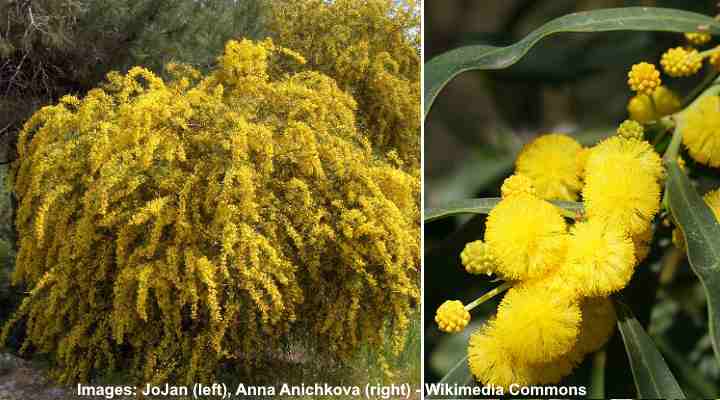
The golden wreath wattle is a stunning yellow-flowering plant that is considered either a small tree or a large shrub, making it suitable for various garden settings. Its stunning bright yellow spherical flowers put on a captivating show during the spring season. The tree’s long, lanceolate, blue-gray leaves, which can grow up to 10 inches (25 cm) long, provide a beautiful contrast to the vibrant blooms. Throughout the season, elongated, flattened seed pod clusters emerge, containing small, round, black seeds.
The golden wreath wattle tree is often used as an ornamental feature to enhance the charm of parks and gardens. It is fast-growing and proves to be resilient in desert-like conditions. While it can adapt to different soil types, it thrives best in well-draining soils with sandy or loamy textures. The golden wreath wattle’s radiant flowers and appealing foliage make it a delightful and eye-catching addition to any landscape.
Mature Size: 10 to 26 ft. (3 to 8 m)
USDA Hardiness Zones: 9-11
Sun: Full sun
Sweet Acacia (Vachellia farnesiana)

Texas Huisache (Sweet Acacia) (Vachellia farnesiana)
The sweet acacia tree is a dwarf variety characterized by its dazzling clusters of yellow-golden, puffball-like flowers. These highly-aromatic, charming blossoms captivate the attention of bees, butterflies, and other pollinators during the late winter and spring seasons. Adding to its ornamental beauty are its feathery, fern-like leaves.
These trees grow best in loose, dry to medium, well-drained soils. Once established, they exhibit great tolerance to both drought and salt, making them well-suited for coastal gardens and foundation plantings. In addition, the sweet acacia’s thorny branches and evergreen foliage create an excellent and natural security screen.
Mature Size: 15 to 20 ft. (4.5 – 6 m) tall and wide
USDA Hardiness Zones: 9 to 11
Sun: Full sun to partial shade
Yellow Bell Orchid Tree (Bauhinia tomentosa)

The yellow bell orchid tree can be identified by its vibrant yellow bell-shaped flowers, resembling orchids. These distinctive flowers showcase large, pale greenish-yellow petals with a dark maroon base, creating a striking display. Another appealing feature of this ornamental tree is its unique leaves, which have two oval lobes resembling wings, along with long, flattened brown seed pods.
The exotic yellow flowers truly stand out against the dark green leaves, adding a touch of beauty to the landscape.
Yellow orchid trees are native to tropical and subtropical regions and thrive best in well-drained soil. They are drought-tolerant once established and require six to eight hours of daily sunlight. They produce delightful nectar that attracts butterflies and bees during the summer, making them a charming addition to any outdoor space.
Mature Size: Up to 24 ft. (7 m) tall and wide
USDA Hardiness Zones: 9 to 11
Sun: Full sun
Palo Verde (Parkinsonia aculeata)
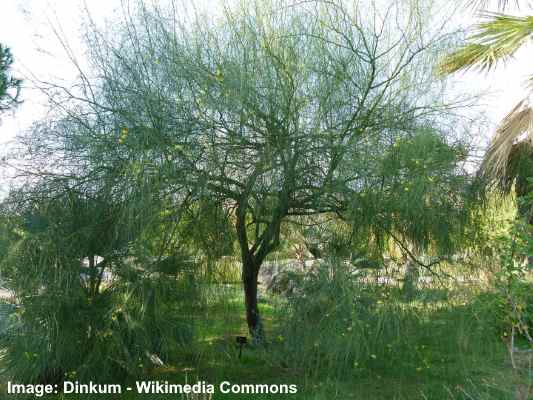
The palo verde tree is a dwarf tree that sheds its leaves and grows clusters of sweet-smelling, orange-yellow flowers. You can easily identify this tree by its bright-green bark and compound, bipinnate leaves. The tree also has branches with thorns and long, slender seed pods.

Native to the southwestern part of the United States, the palo verde tree does well in dry and semi-dry areas. Once it’s grown and settled, it can handle drought, salt, and heat without any problems. For the best results, plant it in soil that drains well. Whether you want to use it as the main attraction or for some shade, the palo verde will be a valuable and charming addition to your garden.
Mature Size: 15 to 20 ft. (4 to 6 m)
USDA Hardiness Zones: 8-11
Sun: Full sun
Blue Palo Verde (Parkinsonia florida)
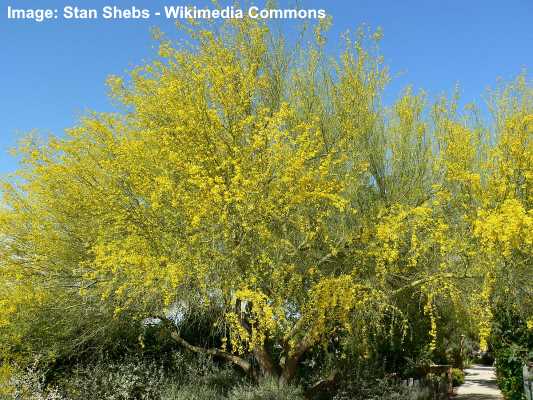
Blue palo verde (Parkinsonia florida) tree in bloom
The blue palo verde is a small tree characterized by its blue-green bark, beautiful clusters of papery, bright yellow flowers with red stamens, and small compound leaves. When spring arrives, the tree turns a lovely golden yellow, making it stand out in arid areas.

Parkinsonia florida flower
This tree is well-suited for places like California, Nevada, and Arizona where the climate is dry. It can handle tough conditions like drought and poor soil, making it a great choice for gardens in these regions such as xeriscape landscapes and desert gardens. It is also used to prevent erosion in difficult soils.
Interestingly, the blue palo verde is Arizona’s state tree.
Mature Size: 20 to 25 ft. (3 – 7.5 m) tall and up to 20 ft. (6 m) wide
USDA Hardiness Zones: 8 to 11
Sun: Full sun
Palo Brea (Parkinsonia praecox)

The palo brea tree stands out with its yellow flowers, chartreuse-green bark, and twisted branches, forming a wide, umbrella-shaped canopy. During mid- to late-spring, it adds a bright touch to the landscape with its vibrant yellow blooms, which contrast beautifully against the green foliage.
Palo brea trees are well-adapted to survive drought and extreme heat, making them tough in arid conditions. They thrive in sunny spots and are great choices for xeriscape gardens or as specimen trees in desert landscapes. With their unique green bark and cheerful yellow flowers, they’ve become a popular option for adding color and visual appeal to desert surroundings.
Mature Size: 20 to 25 ft. (6 – 7.6 m) tall and wide
USDA Hardiness Zones: 9 to 11
Sun: Full sun
Yellow Bells (Tecoma stans)

The yellow bells, also known as the yellow trumpet flower, is a beautiful small ornamental tree. This tree resembles a shrub and produces clusters of brightly colored, funnel-shaped tubular flowers. These vibrant yellow blooms decorate the tree from spring until the first frost, creating a stunning display that lasts all season.
Native to Texas, Florida, and New Mexico, it’s a tough tree that can handle hot and dry conditions, making it an excellent choice for brightening up xeriscape gardens in arid, desert areas. In addition, this tree requires minimal maintenance and can be easily pruned to maintain its desired size and shape.
Mature Size: 10 to 25 ft. (3 – 7.5 m) tall and wide
USDA Hardiness Zones: 9 to 11
Sun: Full sun or partial shade
Lilac ‘Primrose’ (Syringa vulgaris ‘Primrose’)
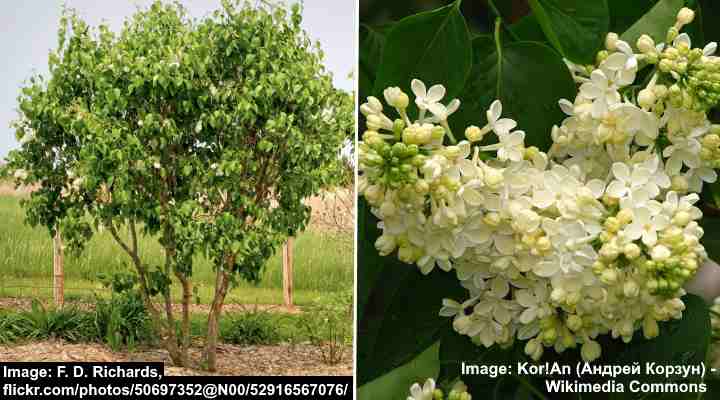
The ‘Primrose’ lilac variety is a shrub or dwarf tree known for its beautiful pale yellow flowers. In late spring, this deciduous shrub produces upright, conical clusters of fragrant, creamy-yellow flowers that last for about four weeks. These attractive blooms are loved by butterflies and bees, making your garden even more charming.
The ‘Primrose’ lilac tree has unique, heart-shaped green leaves that transition into a yellowish hue in the fall, adding a delightful touch of fall colors to your garden. This shrub is easy to care for and thrives in well-draining soil.
With its striking spring blooms, the yellow-flowering lilac ‘Primrose’ can be used as a flowering hedge, for foundation planting, or as part of a perennial border, enhancing the beauty of your landscape.
Mature Size: 10 to 12 ft. (3 – 3.6 m) tall and wide
USDA Hardiness Zones: 4 to 7
Sun: Full sun to partial shade
Yellow Oleander (Cascabela thevetia)

The yellow oleander is a delightful small evergreen tree known for its pretty yellow trumpet-shaped flowers. It thrives best in warm climates and continues to add beauty to the landscape from summer through fall with its showy yellow blooms. The tree has long, slender leaves similar to willow leaves, and in late summer and fall, it develops dark red-black seed pods, which enhance its overall charm.
Though the yellow oleander is appealing for its ornamental qualities, it’s essential to note that all parts of this tree are toxic if eaten. Make sure to plant with caution, especially in places where there might be children or pets. Despite this, it is still a popular choice for parks and gardens as a small, easy-to-care-for decorative tree.
Mature Size: Up to 8 ft. (2.4 m) tall and 4 ft. (1.2 m) wide
USDA Hardiness Zones: 8 to 10
Sun: Full sun to partial shade
Yellow Flowering Camellia Tree (Camellia)
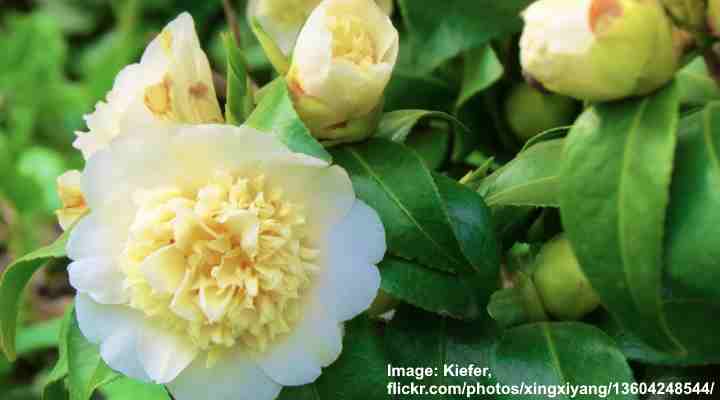
Yellow-flowering camellia trees are known for their eye-catching yellow blooms that create a beautiful contrast with their dark, glossy green leaves. These dwarf, evergreen camellia trees are well-known for their large and striking flowers, some of which have ruffled double blooms. During early spring, the trees produce plenty of pale yellow flowers, adding a vibrant touch of color.
For optimal growth, yellow camellia trees prefer acidic and well-drained soil, and they thrive in partial shade to full sun. This versatile plant can be used as a focal point in gardens or as a hedge to create privacy. With their stunning flowers and glossy evergreen leaves, camellia trees add a touch of elegance and charm to any outdoor space.
Mature Size: 10 to 13 ft. (3 – 4 m) tall and 5 to 10 ft. (1.5 – 3 m) wide
USDA Hardiness Zones: 7 to 10
Sun: Partial shade
Weeping Scotch Laburnum (Laburnum alpinum ‘Pendulum’)
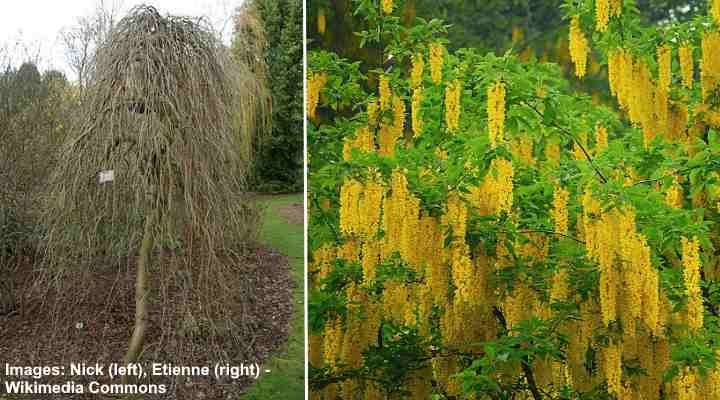
If you’re looking for a beautiful weeping tree with yellow flowers, consider the weeping Scotch laburnum. This dwarf tree has gracefully cascading branches covered with small, sweet-smelling flowers, making it a fantastic addition to temperate climates as an ornamental tree.
The weeping Scotch laburnum is a hardy tree that adapts well to different types of well-drained soil. With its drooping branches and compact stature, it’s an ideal fit for petite gardens. You can use it as a single focal point in small yards or tight spaces, or to enhance the overall appeal of the curb of your front yard.
Mature Size: 6.5 to 8 ft. (2 – 2.5 m) tall and up to 6.5 ft. (2 m) wide
USDA Hardiness Zones: 5 to 7
Sun: Full sun or partial shade
Cornelian Cherry (Cornus mas)
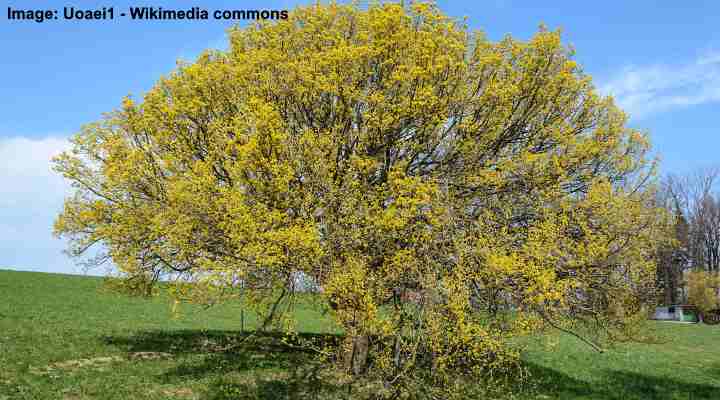
Cornelian Cherry Dogwood (Cornus mas)
The Cornelian cherry is a lovely, small tree with a bush-like appearance, known for its ornamental features and bright yellow flowers. During early spring, usually from late February to early March, this tree adorns its bare branches with a stunning array of golden-yellow blooms before the leaves emerge.
Throughout the season, the tree’s foliage turns into a deep shade of green with oval leaves, and by midsummer, it produces eye-catching red berries.
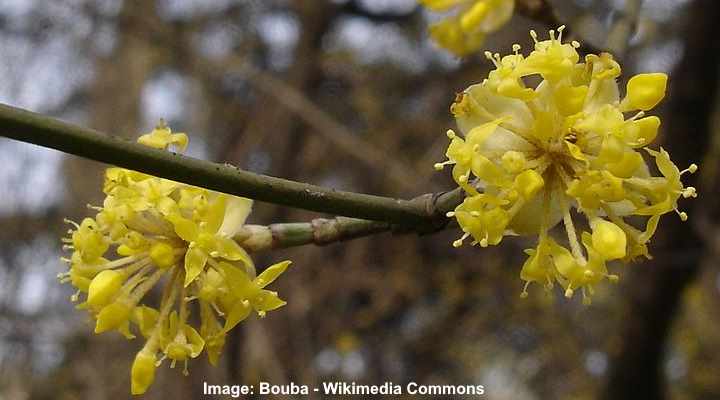
The Cornelian cherry tree exhibits remarkable adaptability, thriving in a diverse range of soil conditions. This versatility allows them to be used as ornamental trees, hedges, privacy screens, or as specimen plants to beautify landscapes. The tree’s charming yellow flowers and delectable red fruits make it a favored selection for beautifying gardens.
Mature Size: 15 to 25 ft. (4.5 – 7.6 m) tall and 21 to 20 ft. (3.6 – 6 m) wide
USDA Hardiness Zones: 5 to 8
Sun: Full sun to partial shade
Golden Wonder Tree (Senna spectabilis)
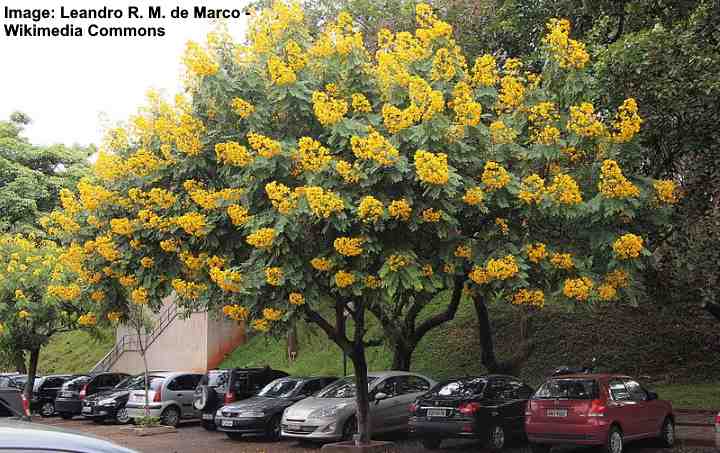
Senna spectabilis
The golden wonder tree is a beautiful small tree that adds beauty to any garden. In the summer, it stands out for its abundant bright yellow flowers, growing in clusters up to 2 inches (50 cm) long. The tree’s leaves are shaped like ferns and come together to create compound leaves that can reach up to 3 inches (7.5 cm) in size.
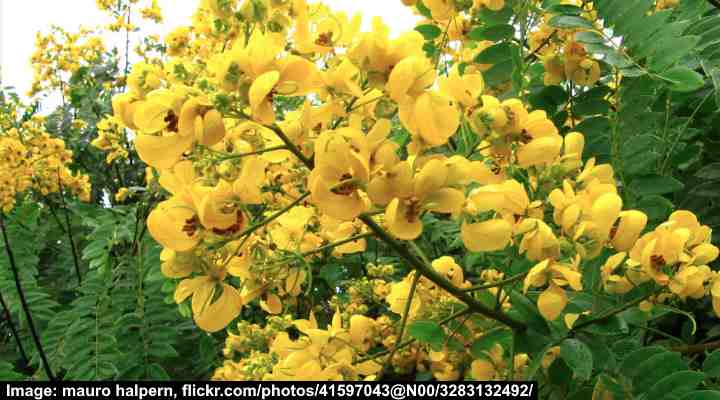
With its enchanting golden yellow flowers, this tree is a top choice for adding ornamental charm to your garden, especially in the front yard or as a shade provider. One of the best things about this tree is its rapid growth, and drought- and heat-tolerance, as well as its adaptability to various soil types. For tropical gardens, the golden wonder tree is an ideal choice, bringing a burst of yellow-flowering beauty.
Mature Size: 15 to 20 ft. (4.5 – 6 m) tall and wide
USDA Hardiness Zones: 9 to 11
Sun: Full sun
Candelabra Tree (Senna didymobotrya)
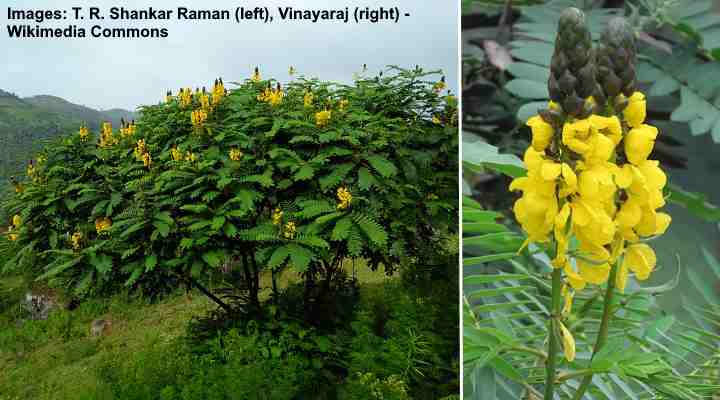
The candelabra tree is a small, ornamental tree appreciated for its bright, beautiful yellow blossoms. Some other names for this tree are popcorn tree or peanut butter cassia. This tree stands out with its distinct characteristics, displaying cone-like clusters of bright yellow flowers, large oval leaves, and long bean-like seed pods. What makes it even more intriguing is that its golden flowers give off scents reminiscent of peanut butter, burnt popcorn, or even a wet dog.
The yellow-flowering candelabra tree thrives in warm, humid climates and prefers well-drained, fertile soil. This sun-loving tree is an excellent choice for enhancing your landscape, whether as an ornamental tree or an accent piece. Its vibrant yellow flower clusters add a delightful burst of color to your garden while attracting essential pollinators like butterflies and bees.
Mature Size: Up to 16 ft. (5 m) tall
USDA Hardiness Zones: 9 to 11
Sun: Full sun
Cudjoe Wood Tree (Bonellia macrocarpa)

The cudjoe wood tree is a unique, dwarf tree that produces charming, star-shaped orange flowers. It was introduced to Florida and can handle hot weather well, thriving in sunny locations. The tree bears flowers rich in nectar and has a wide-spreading canopy with dense, evergreen leaves that are long and lance-shaped, measuring between 1.5 to 2.8 inches (4 – 7 cm).
This tree can withstand drought and salty conditions, making it an excellent choice for gardens near the coast. It prefers well-drained soil and full sunlight, although it can tolerate some shade. During the spring and early summer, it blooms, attracting bees and butterflies for pollination.
Mature Size: 6 to 15 ft. (1.8 – 4.5 m) tall
USDA Hardiness Zones: 10 and 11
Sun: Full sun
Orange Bottlebrush Tree (Callistemon ‘Tangerine Dream’)

The orange bottlebrush is an adaptable shrub that can be easily shaped into a delightful, small ornamental tree. The ‘Tangerine Dream’ variety features bright orange flowers that look like bottle brushes, giving it a distinct and attractive appearance. The decorative flowers mainly bloom in spring but delight your garden with occasional appearances throughout the year, attracting hummingbirds and butterflies.
Gardeners love the orange bottlebrush tree due to how it brings vibrant colors to their gardens and landscapes. With its bushy growth, it is perfect for creating a relaxed hedge or an evergreen screen. Additionally, this dense shrub flourishes in containers, making it a perfect option to bring vibrancy to patios or decks.
Mature Size: 5 to 6.5 ft. (1.5 – 2 m) tall and 3 to 5 ft. (1 – 1.5 m) wide
USDA Hardiness Zones: 10 to 12
Sun: Full sun
Chilean Orange Ball Tree (Buddleja globosa)

The orange ball tree is a charming, lush plant famous for its bright orange, tubular flowers arranged in spherical clusters. These flowers have a pleasant fragrance and bloom all summer, attracting pollinators such as butterflies and bees. Its golden yellow to orange spherical flowerheads add a burst of lively color to any garden.
This tree, also referred to as the orange flowering butterfly bush, features long, lance-shaped leaves in a gray-green hue. Its canopy is nicely rounded, and it grows compactly, making it an excellent choice for brightening small gardens and tight spaces. Trimming the dwarf tree is effortless, allowing you to easily maintain its size and shape.
The Chilean orange ball tree can withstand drought and thrives in well-draining, loamy soil. It also has a natural resistance to deer, which is beneficial for those residing in rural areas.
Mature Size: 10 to 15 ft. (3 – 4.5 m) tall and wide
USDA Hardiness Zones: 7 to 10
Sun: Full sun
Flowering Maple ‘Victor Reiter’ (Abutilon ‘Victor Reiter’)
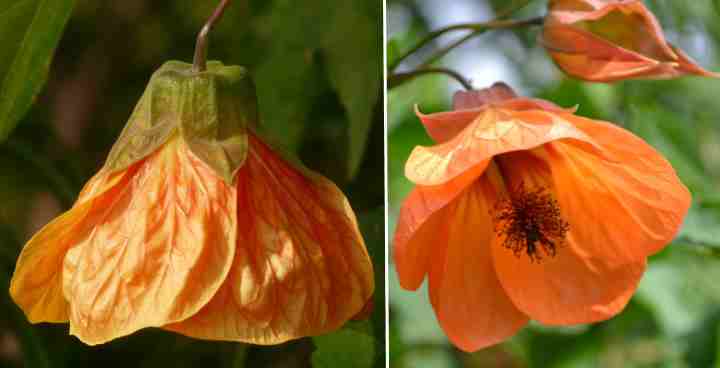
The ‘Victor Reiter’ flowering maple is a delightful small tree known for its bright bell-shaped orange flowers. These flowers face outward and have a lively orange color with greenish-yellow centers. They gracefully hang from the branches, resembling hibiscus flowers or colorful bells. The ‘Victor Reiter’ type is especially known for its profuse and persistent blooms.
This tree loves sunlight and has dark green leaves similar to those of a maple. The lush foliage complements the decorative orange blooms, which persistently grace the landscape from spring until autumn. Flowering maples with pretty orange blossoms are an excellent choice for adding a burst of color to small gardens, container gardens, or as a focal point in any landscape.
Flowering maples thrive in soil that is well-draining, consistently moist, and supplemented with organic matter. With their never-ending blooms and alluring foliage, they are widely favored for enhancing the aesthetics of gardens.
Mature Size: 6 to 8 ft. (1.8 – 2.4 m) tall and 4 ft. (1.2 m) wide
USDA Hardiness Zones: 9 to 11
Sun: Full sun to partial shade
Geiger Tree (Cordia sebestena)
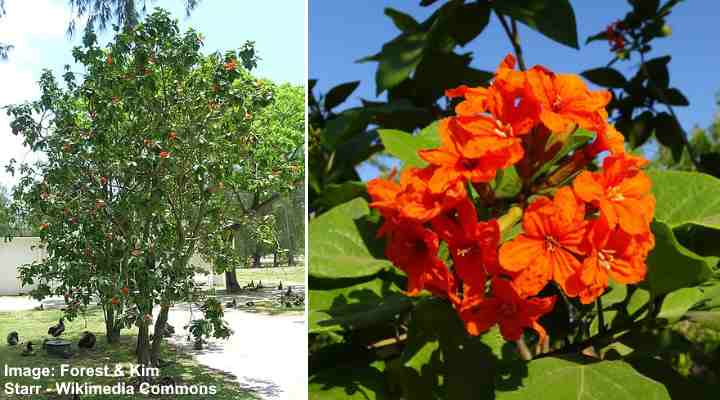
The Geiger tree is a charming, small flowering tree with beautiful orange-red flowers and heart-shaped leaves. These trumpet-shaped flowers cover the rounded canopy with bright orange colors throughout summer and fall. The tree has several unique features, including its irregularly shaped branches, continuous blooming throughout the year, and white, egg-shaped fruits.
This small orange flowering tree is native to Florida and is commonly found in tropical landscapes. Its compact size and moderate height make it a perfect tree for small gardens or as a complement to larger trees.
If you live in coastal areas, the geiger tree can be a great addition to your landscaping. It can handle brackish water, making it ideal for beach or seaside gardens. In addition, it requires minimal maintenance and can thrive in various soil types, including sandy or clay soils.
Mature Size: 10 to 30 ft. (4.5 – 7.6 m) tall and up to 15 ft. (4.5 m) wide
USDA Hardiness Zones: 10 and 11
Sun: Full sun, light shade, or dappled sunlight
Flame Azalea (Rhododendron calendulaceum)

The flame azalea is a beautiful, deciduous shrub that can be shaped as a small tree. It is known for its stunning display of orange flowers that bloom in late spring and summer. These eye-catching flowerheads resemble fiery candle flames and stay in bloom for about two weeks. The shrubby tree can be trained to grow in a tree-like shape, forming a rounded canopy covered with beautiful orange-red flowers.
During autumn, the flame azalea’s green leaves with a fuzzy texture turn yellow and pale orange, creating a lovely array of fall colors. The dwarf tree is perfectly suited for foundation planting, blending in mixed borders, or as a privacy screen.
To ensure the flame azalea thrives, plant it in acidic, well-drained soil and provide partial shade. For a more abundant display of blooms, just trim away the faded flowers, and the ornamental shrub or tree will reflower during late summer.
Mature Size: 4 to 8 ft. (1.2 – 2.4 m) tall and wide
USDA Hardiness Zones: 5 to 8
Sun: Partial shade or full sun
Fragrant Orange Tea Olive (Osmanthus fragrans f. aurantiacus)

The charming tea olive tree is a small and resilient evergreen tree well-known for its highly scented, tangerine-colored flowers. These little, tube-shaped orange flowers grow together in clusters and give off a sweet fragrance reminiscent of apricots. The soft, citrusy hue of the blossoms perfectly complements the lustrous, deep green foliage.
With its fragrant scent and dense canopy of dark green, pointed, oval-shaped leaves, the olive tree becomes an ideal choice to maintain greenery all year round. These trees can be used in landscaping to create evergreen hedges and privacy screens, or as foundation planting or a stand-alone focal point. Moreover, they make an excellent choice for container planting, adding elegance to patios or entryways.
Mature Size: 10 to 15 ft. (3 – 4.5 m) tall and 6 to 8 ft. (1.8 – 2.4) wide
USDA Hardiness Zones: 7 to 10
Sun: Full sun to partial shade
Scarlet Wisteria (Sesbania punicea)

The scarlet wisteria is an attractive dwarf tree or shrub known for its clusters of bright orange to red flowers, resembling the cascading blooms of wisteria plants. From late spring to early summer, these attractive flowers display their beauty and attract hummingbirds and butterflies.
The scarlet wisteria, also referred to as rattlebox or Spanish gold, showcases compound leaves featuring small green or grayish-green leaflets. It grows in a bushy, multi-stemmed manner and has a spreading growth habit. You can either shape it into a small tree or let it grow naturally as a shrub.
Scarlet wisterias are adaptable plants capable of thriving in dry environments and flourishing across diverse landscapes. They make excellent shade trees for backyards and gardens, adding an ornamental touch. The ornamental orange flowers also create beautiful informal hedges or screens. Container gardeners will find these small trees thrive exceptionally well on patios.
It’s important to remember that all parts of the plant are toxic, so caution should be exercised.
Mature Size: 10 to 15 ft. (3 – 4.5 m) tall and wide
USDA Hardiness Zones: 8 to 11
Sun: Full sun to light shade
Orange Bells (Tecoma alata)
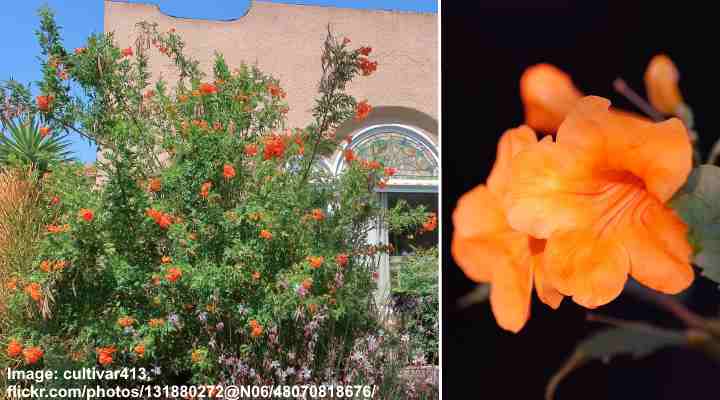
Orange bells is an attractive shrub that can be shaped into a small tree. Some of its most attractive features are its vibrant tubular orange flowers, which are shaped like trumpets and bloom from late spring and continue throughout the summer. These sweet-smelling orange flowers, with flared petals, hold a special appeal for hummingbirds and butterflies, making the tree a favorite in wildlife gardens.
The orange bells tree showcases glossy, dark green leaves with a slightly fuzzy texture. With its delightful blend of orange and green hues, it becomes an excellent selection as a standout plant, an evergreen flowering hedge, or an addition to mixed borders. Additionally, it adapts well to large containers on patios or in small gardens.
This small evergreen shrub-like tree adapts well to various soil types but favors well-drained soil. This plant is easy to care for and can tolerate drought, heat, and salty air, making it perfect for semi-tropical coastal landscapes and arid conditions.
Mature Size: 8 to 12 ft. (2.4 – 3.6 m) tall and wide
USDA Hardiness Zones: 8 to 11
Sun: Full sun to partial shade
Elder Tree (Tecoma Stans ‘Orange Jubilee’)
The ‘Orange Jubilee’ is a popular, evergreen tree known for its attractive, orange trumpet flowers and beautiful spreading shape. These flowers are large and eye-catching, remaining in full bloom for an extended period, attracting pollinators and hummingbirds with their pleasant aroma.
The elder tree features lance-shaped leaves with a glossy, dark green appearance and serrated edges. This versatile tree can be used as a shade provider, privacy screen, hedge, or in foundation planting.
The ‘Orange Jubilee’ elder tree is perfect for hot and dry climates. It can handle drought and thrives in sunny conditions all day long.
Mature Size: 10 to 20 ft. (2.4 – 3.6 m) tall and 8 to 12 ft. (2.4 – 3.6 m) wide
USDA Hardiness Zones: 9 to 11
Sun: Full sun
Red Flowering Camellia (Camellia japonica)
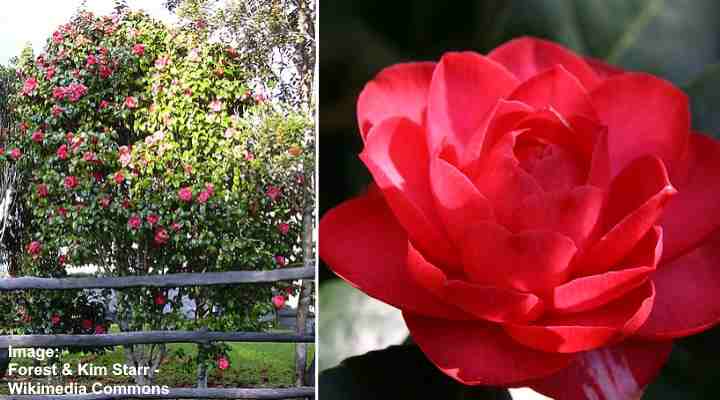
The red-flowering camellia is an evergreen tree that stands out for its vibrant red flowers. The blossoms have a pleasing, symmetrical shape, resembling roses or peonies. These striking red flowers bloom during late winter or early spring, adding color to your garden when most other plants are dormant.
In addition to its beautiful red peony-like flowers, the evergreen camellia has glossy green leaves that create an attractive backdrop against the red blooms. This versatile plant can be cultivated as either a tree or a shrub, providing exceptional visual appeal.
Here are some red-flowering camellia varieties that flourish in various light conditions, ranging from full sun to shade:
Camellia japonica ‘Kramer’s Supreme’: This tree produces an abundance of stunning red peony-type flowers from late winter through spring.
Camellia japonica ‘Australis’: This camellia delights with its rose-red flowers made up of wavy, ruffled petals, blooming for several months, starting in late winter.
Camellia japonica ‘Bob Hope’: This variety features deep red semi-double blossoms with beautiful yellow stamens, creating a burst of vibrant color in spring.
Camellia japonica ‘Lady Campbell’: This variety’s glossy dark green leaves provide a stunning backdrop against its bright red, rose-form flowers, infusing any garden or landscape with a burst of vibrant color.
Mature Size: 6 to 12 ft. (1.8 – 3.6 m) tall and 6 to 10 ft. (1.8 to 3 m) wide
USDA Hardiness Zones: 7 to 9
Sun: Partial shade to deep shade
Waratah (Telopea speciosissima)

The waratah tree is well-known for its vibrant, round clusters of flowers that come in attractive shades of red or pink. These beautiful flowers look similar to classic waratah blossoms and are perched at the ends of elongated stalks. The flower head is composed of several small flowers surrounded by vibrant bracts in hues of red, maroon, or pink.
Waratah trees have dark green, leathery leaves with serrated edges. These trees, with their slow growth and compact, dense silhouette, are ideal focal points in gardens or as standalone specimen trees. Their uniquely-shaped blooms also make them a good choice for cut flower arrangements.
To grow waratahs successfully, choose a spot with well-drained soil and provide them with full sun to partial shade. They are tough and can tolerate different soil types and occasional drought once they’re established. However, it’s a good idea to shield them from strong winds.
Mature Size: 3 to 10 ft. (1 – 3 m) tall and wide
USDA Hardiness Zones: 8 to 10
Sun: Full sun to partial shade
Red Flowering Grevillea Trees
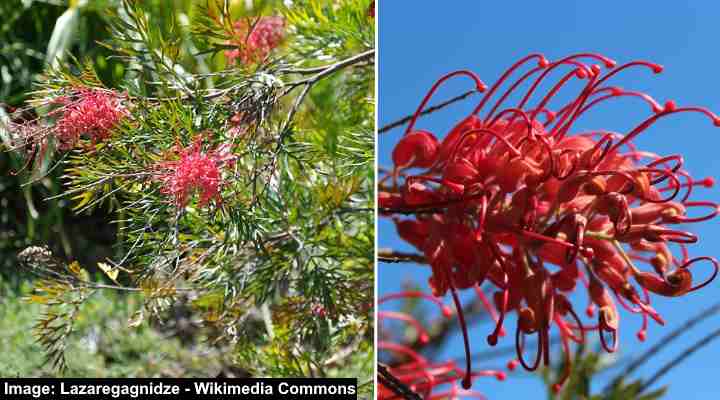
The red-flowering grevillea tree is renowned for its year-round display of vibrant red blooms. This dwarf tree produces multiple cylindrical clusters of red flowers, each with distinct, curled petals and attractive arching stamens. The red flowers are especially inviting to birds and bees, making them a valuable addition to any garden or landscape.
The leaves of grevillea trees are slender and resemble ferns, often found in shades of dark green or silver-gray. Their ability to tolerate drought makes them well-suited for xeriscape gardens, coastal landscapes, and dry conditions. Grevillea trees are versatile and can serve as hedges, screens, specimen plants, or windbreaks, providing various options for different gardening needs.
Mature Size: 4 to 8 ft. (1.2 – 2.4 m) tall, depending on the species
USDA Hardiness Zones: 9 to 11
Sun: Full sun to partial shade
‘Hardy Red’ Oleander (Nerium oleander ‘Hardy Red’)
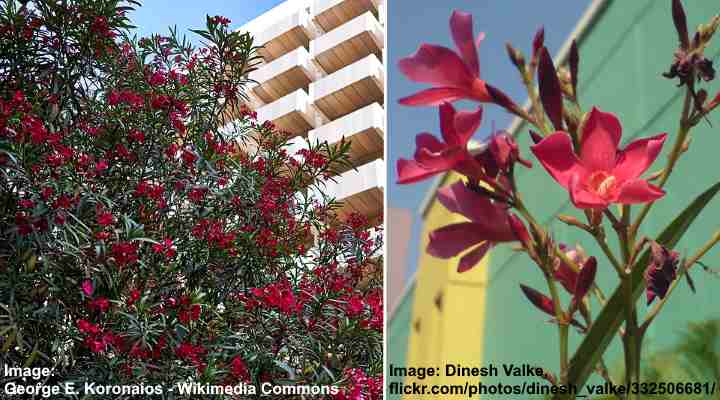
The ‘Hardy Red’ oleander is a captivating shrub or dwarf tree admired for its deep red flowers. These flowers, shaped like funnels, brighten up summer gardens with vibrant colors. From spring to fall, the plant gets covered in clusters of five-petaled, deep red flowers. The ‘Hardy Red’ variety stands out for its increased resilience to cold temperatures when compared to other types of oleander.
The ‘Hardy Red’ oleander’s canopy forms a vase shape and is covered with long, dark green lanceolate leaves. This multi-stemmed shrub or small tree does well as a red-flowering hedge, evergreen privacy screen, or attractive standalone plant. Additionally, it can withstand drought conditions and needs little maintenance, making it a great choice for gardens in hot and arid regions.
Keep in mind that all parts of the oleander plant are toxic if ingested, so be cautious when planting it in areas where children or pets might be present.
Mature Size: 6 to 15 ft. (1.8 – 3.6 m) tall and up to 10 ft. (3 m) wide
USDA Hardiness Zones: 7 to 12
Sun: Full sun
Pomegranate Tree (Punica granatum)
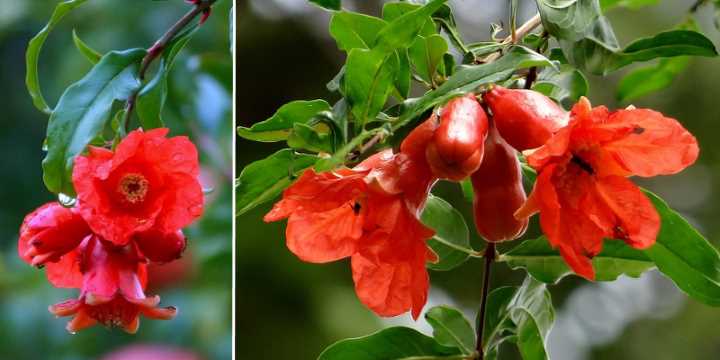
Pomegranate flowers
The pomegranate tree is a small tree or shrub renowned for having bright red flowers and sweet, juicy fruit. The cup-shaped flowers have crinkled petals and yellow-tipped stamens in the center. Following the blooming of the flowers, the tree produces juicy, round pomegranate fruits with a delightful sweet and tart flavor.
You can recognize pomegranate trees by their multiple stems, evergreen, oblong leaves, and beautiful flowers that bloom in the summer. When fall comes, the leaves turn a vibrant yellow, adding to the tree’s seasonal appeal. These trees are perfect for Mediterranean-style gardens and can thrive when grown in containers on patios or balconies.
Mature Size: 6 to 20 ft. (1.8 – 6 m) tall and 4 to 5 ft. (1.2 – 4.5 m) wide
USDA Hardiness Zones: 8 to 11
Sun: Full sun
Crabapple (Malus prairifire)
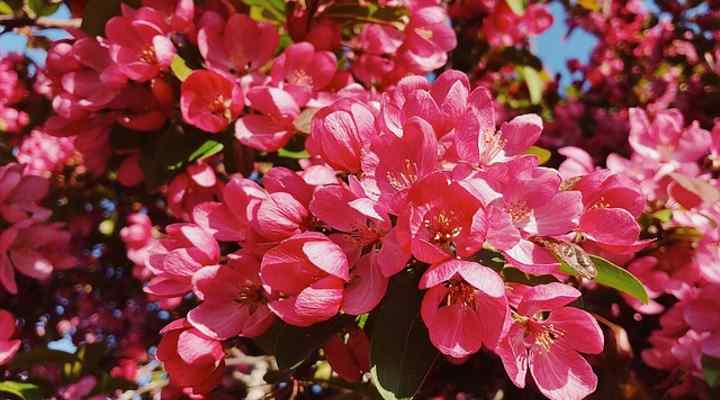
The ‘Prairifire’ crabapple is a small, fruit-bearing tree renowned for its beautiful dark pink to red blossoms. These flowers burst into bloom in dense clusters, decorating the upright, rounded canopy from mid to late spring. The tree’s eye-catching red colors elevate the visual appeal of any landscape. Additionally, after the flowering period, small apples resembling cherries appear.
‘Prairifire’ crabapple trees feature dark green leaves highlighted by purplish-red veins. During autumn, the thick foliage transforms into a breathtaking golden-bronze, beautifying the fall landscapes. The tree’s glossy, crimson bark with distinctive lenticels enhances its overall charm.
Prairifire crabapple trees are grown often in small gardens due to their decorative appeal. They flourish in soil that is moderately fertile and well-draining. These trees are perfect for wildlife gardens due to their flowers and fruit, which attract pollinators, birds, and other wildlife.
Mature Size: 15 to 20 ft. (4.5 – 6 m) tall and wide
USDA Hardiness Zones: 4 to 8
Sun: Full sun
Chinese Hibiscus Tree (Hibiscus rosa-sinensis)

The Chinese hibiscus, a tropical evergreen tree, is famous for its stunning red trumpet-like flowers, that emit a delightful floral fragrance. Their delicate, paper-like petals and noticeable stamen contribute to their charm, forming funnel-shaped blooms that can reach up to 4 inches (10 cm) in diameter.
The Chinese hibiscus’s bright red flowers are in high demand for tropical gardens due to their ornamental beauty. Other identifying features of this plant are its shiny, lance-shaped leaves that are rich, dark green in color. In tropical climates, it maintains its evergreen foliage, but in colder regions, it may shed leaves.
Chinese hibiscus plants thrive best in well-drained soil and prefer full sun to partial shade for optimal growth. In tropical regions, consistent watering is essential, particularly during dry spells. Within gardens, these ornamental trees serve versatile roles, functioning as shrubs for their beauty, acting as privacy hedges or screens, and attracting pollinators. In cooler climates, they can be cultivated in containers and brought indoors for overwintering.
Mature Size: 8 to 16 ft. (2.5 – 4.9 m) tall and 5 to 10 ft. (1.5 – 3 m) wide
USDA Hardiness Zones: 10 to 12
Sun: Full sun to partial shade
Red Frangipani Tree (Plumeria Rubra)
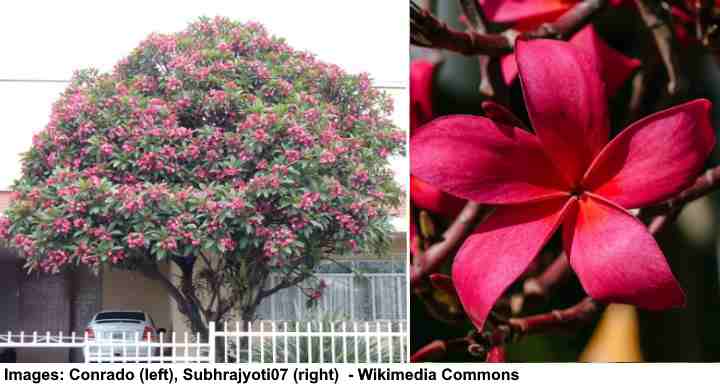
The red frangipani is a tropical tree known for its large star-shaped red flowers. These impressive blooms showcase a vibrant magenta-red hue and release a delightful fragrance. The tree’s lush foliage, deep pink or red flowers, and elongated seed pods are the reasons for its popularity in tropical gardens and landscapes.
The red frangipani’s year-round blooming ensures a continuous display of beauty in outdoor spaces. The eye-catching red flowers stand out beautifully against the dense, dark green foliage. Being a small to medium-sized tree, the red frangipani fits well in gardens of various sizes.
Native to the tropical regions of Mexico and Central America, the red frangipani thrives in climates that are both hot and humid. This heat-tolerant tree thrives in flower beds and borders, making it a perfect fit as a patio tree or a container plant. In addition, the tree thrives in soils that are moderately moist and well-drained.
Mature Size: 15 to 25 ft. (4.5 – 7.5 m) tall and wide
USDA Hardiness Zones: 10 to 12
Sun: Full sun
Crimson Bottlebrush Tree (Melaleuca citrina)
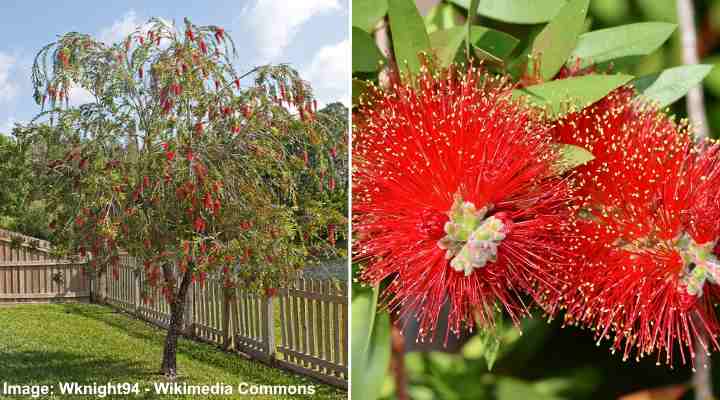
The red bottlebrush tree is a compact evergreen tree with dense growth, recognized for its distinctive bottlebrush-like flowers. These elongated, fuzzy, conical flowers are vibrant red in color and attract pollinators, including bees, butterflies, and hummingbirds. This tree is alternatively referred to as the lemon bottle brush due to its leaves releasing a citrus aroma when crushed.
The bottlebrush tree features slender, glossy, dark green leaves. During autumn, the lanceolate leaves transition to a coppery-brown color. After the blooming phase, the tree develops and retains woody, cup-shaped seed capsules throughout the winter. The bright red flowers create a stunning contrast against the glossy green leaves.
The red bottlebrush tree flourishes in full sunlight and prefers well-draining soil. This tree serves well as an ornamental shrub, flowering hedge, or foundation plant in landscaping. Its tolerance to salty air makes it an excellent choice for coastal gardens.
Mature Size: 8 to 15 ft. (2.4 – 4.5 m) tall and wide
USDA Hardiness Zones: 8 to 11
Sun: Full sun, six hours of direct sunlight or more
Purple Flowering Crabapple Trees (Malus spp.)
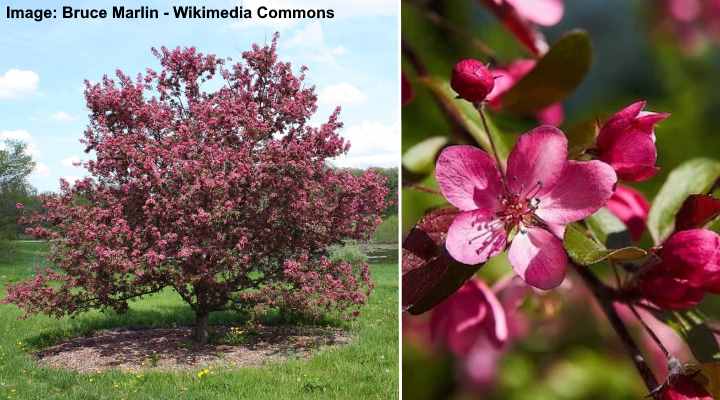
Crabapple Purple Prince (Malus ‘Purple Prince’)
Purple flowering crabapple trees are part of a category of small to medium-sized fruiting trees, with certain varieties showcasing stunning purple blooms. During early spring, these trees burst into bloom, adorning their branches with an abundance of flowers that release delightful fragrances. Some types of purple-flowering crabapple trees feature eye-catching dark purple leaves and produce small apple-like fruits.
Purple-flowering crabapple trees are versatile and can be used in different landscaping arrangements. Whether used as standalone focal points, in group plantings, or arranged in rows for hedging, these trees adapt well to various settings. These plants display resilience, tolerating different soil types. Additionally, they enrich autumn landscapes with their stunning red, purple, and yellow shades.
Let’s take a look at two varieties of small crabapple trees with beautiful purple flowers:
Malus ‘Kelsey’: This resilient crabapple variety blooms in spring, displaying numerous semi-double or double purple-red flowers. During spring, its foliage appears in shades of red, transitioning to bronze-green, and finally transforming into orange and yellow in the fall. This small crabapple displays an upright growth form and a rounded silhouette, growing to a height and width of 15 to 18 feet (4.5 – 5.4 meters).
Malus ‘Purple Prince’: This fruit-bearing deciduous tree is small to medium-sized, characterized by a rounded or slightly spreading crown and a dense, compact growth pattern. The tree’s standout features are its deep purple-to-pink flowers and purple foliage. The purple prince crabapple flourishes in full sun and well-drained soil, growing to a height and width of 18 to 20 feet (5.4 – 6 meters).
Purple Flowering Crape Myrtle (Lagerstroemia)
The purple flowering crape myrtle is a beautiful small shrub-like tree renowned for its plentiful clusters of vibrant purple flowers with crinkled petals. These showy clusters bloom from summer through early autumn and display shades ranging from deep violet to lavender and pale blue.
In addition to their stunning purple flowers, crape myrtle trees feature other ornamental attributes. Crape myrtle trees have smooth bark that peels, and thick oval leaves with a leathery texture. Throughout the summer, the glossy, dark green foliage adds to the tree’s attractiveness, transforming into vibrant hues of orange, red, or yellow in autumn, further enhancing its overall charm.
Crape myrtle trees are hardy, capable of enduring drought conditions, and adaptable to different soil types.
Here are some crape myrtle varieties that have purple flowers:
Lagerstroemia ‘Purple Magic’: This breathtaking crape myrtle cultivar showcases vibrant purple flowers in the summer season. This crape myrtle is an excellent selection for forming a flowering hedge, foundation planting, or privacy screen. At maturity, the purple crape myrtle tree typically reaches a height and width of 6 to 10 ft. (1.8 – 3 m).
Lagerstroemia ‘Early Bird’: Grown as a small tree or compact shrub, this crape myrtle displays clusters of vibrant purple flowers. As the name suggests, this crape myrtle variety is an early bloomer, standing at a height of 5 to 6 ft. (1.5 – 1.8 m) with a width of 4 ft. (1.2 m).
Lagerstroemia ‘Infinitini Purple’: This compact crape myrtle cultivar features plentiful clusters of deep purple flowers, resembling crepe paper with their crinkled petals. This compact crape myrtle is an ideal option for smaller gardens, borders, or foundation planting. At maturity, this small shrub typically reaches a height and width of 3 to 5 ft. (1 – 1.5 m).
Lagerstroemia ‘Infinitini Orchid’: With its stunning appearance, this shrub or small tree is the perfect choice for landscaping in limited spaces or compact gardens. The little tree or shrub showcases brilliant lavender or crinkled purple flowers that bloom from summer through fall, bringing vibrant color to gardens, borders, or containers. When fully grown, this shrub can measure between 2 and 4 ft. (0.6 – 1.2 m) in both height and width.
Catawba Crape Myrtle (Lagerstroemia indica ‘Catawba’): This stunning tree or medium-large shrub features purple flowers and blooms in late summer. The glossy green, dense foliage serves as a striking backdrop for the purple flower clusters, creating a beautiful contrast. At full maturity, Catawba crape myrtle trees generally reach a height and width of 10 to 15 ft. (3 – 4.5 m).
‘Royal Purple’ Smoke Tree (Cotinus coggygria ‘Royal Purple’)

Cotinus coggygria ‘Royal Purple’)
The ‘Royal Purple’ smoke tree, featuring clusters of pinkish-purple plume-like flowers, is a sizable shrub or petite multi-stemmed tree. The tree’s most distinctive feature is the soft, fuzzy plumes, which give it a billowing and ‘smoky’ appearance. These dainty flowers bear a resemblance to wisps of pink, purple, or white smoke, producing a stunning spectacle as they bloom in late spring or early summer.
The foliage of the smoke tree consists of oval-shaped leaves with a deep purple hue, intensifying to a wine-purple shade in the summer months. With the onset of autumn, the leaves undergo a vibrant transformation, turning into shades of striking red. With its dark foliage and enchanting puff-like flowers, the smoke tree becomes a visually appealing addition to any landscape.
Highly adaptable, smoke trees excel as beautiful and complementary elements in any garden. Their exceptional flowers and foliage make them versatile choices, serving as border plants, informal hedges, privacy screens, or foundation plantings.
Mature Size: 10 to 15 ft. (3 – 4.5 m) tall and 15 to 20 ft. (4.5 – 6 m) wide
USDA Hardiness Zones: 4 to 9
Sun: Full sun to partial shade
Purple Flowering Hibiscus Tree (Hibiscus syriacus ‘Purple Satin’ and ‘Azurri Blue Satin’)
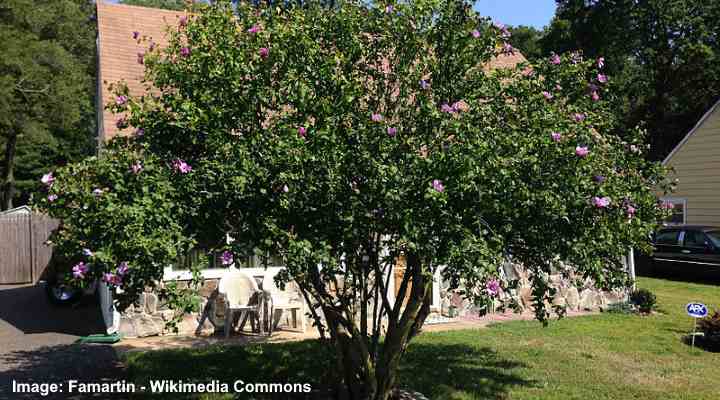
Hibiscus syriacus, commonly referred to as the rose of Sharon, is a flowering shrub that can also be cultivated as a dwarf ornamental tree. Several hibiscus species have striking and vibrant blossoms. These impressive blossoms are commonly trumpet-shaped, adorned with delicate frilly petals and a prominent cone-like stamen.
The purple-flowering Rose of Sharon varieties typically grow to heights between 8 and 10 feet (2.4 to 3 meters) and spread up to 10 feet (3 meters).
Let’s now provide brief overviews of three hibiscus trees with purple blossoms.
Hibiscus syriacus ‘Purple Satin’: This hibiscus type features single flowers with a funnel shape and a deep purple hue. These purple flowers bloom without interruption from summer to fall, making them a wonderful selection for planting near foundations, creating flowering hedges, or serving as privacy screens.
Hibiscus syriacus ‘Azurri Blue Satin’: This variety of Rose of Sharon boasts purple flowers with big, funnel-shaped blooms and charmingly ruffled pale purple petals. This particular flowering shrub or small tree is well-suited for planting at the back of borders, adding a touch of charm to the landscape.
Hibiscus syriacus ‘First Editions French Cabaret Purple’: This multi-stemmed shrub, featuring double purple flowers resembling carnations, is perfect for lining foundations, forming hedges, or attractive shrub borders.
Common Lilac (Syringa vulgaris)
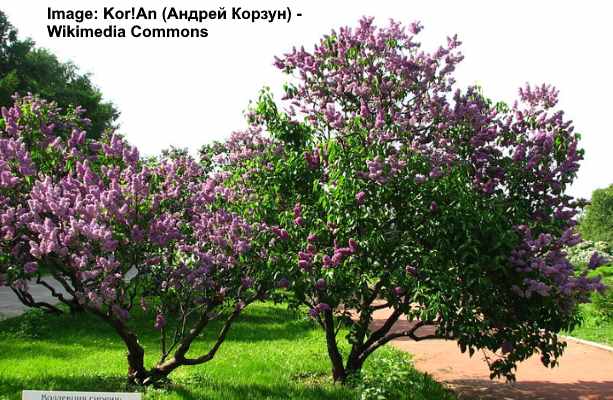
Lilac tree
Characterized by its purple blossoms, the common lilac is a shrub that can be shaped into a petite tree. The plant grows in a bushy manner and displays fragrant, cone-shaped clusters of purple flowers on its gracefully arching branches. Blooming from late spring to early summer, these delightful flowers create a captivating lilac-colored spectacle around the shrub and release a pleasant floral fragrance. Alongside purple, lilac trees can grow charming flowers in hues of white, pink, or blue.
The common lilac has heart-shaped leaves that vary in color from dark green to blue-green. The dense and attractive foliage of this shrub-like tree makes it a great choice for use as a hedge, privacy screen, or specimen tree. You can grow dwarf lilac varieties in containers to add beauty to a deck, patio, or entrance. Common lilacs are hardy and can endure cold weather, including harsh winter conditions.
Common lilacs are a popular choice for ornamental planting due to their low maintenance, drought tolerance, and reliable spring blooms. In addition, their fragrant blooms lure butterflies and bees, making them a favorite among pollinators.
Mature Size: 8 to 10 ft. (2.4 – 3 m) tall and 5 to 6 ft. (1.5 – 1.8 m) wide
USDA Hardiness Zones: 3 to 8
Sun: Full sun for best flowering
Purple Flowering Dogwood (Cornus florida ‘Purple Glory’)
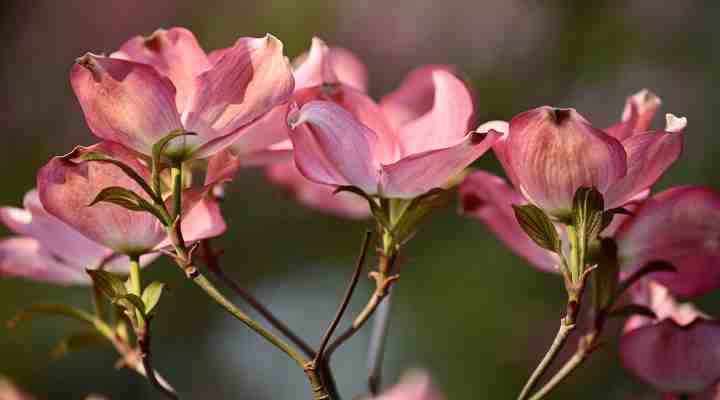
The small and ornamental purple flowering dogwood tree is known for its vibrant purple blooms. The flower-like structures, resembling colorful petals, are in fact reddish-purple bracts that appear during spring. With its dark purple leaves, the ‘Purple Glory’ cultivar becomes even more visually appealing as an ornamental choice. The tree’s leaves change to a captivating black-purple hue during the autumn season.
The purple flowering dogwood’s rapid growth and compact size result in a rounded canopy. The tree maintains its deep and dramatic colors, even when fully exposed to the sun, until the leaves eventually fall in autumn. These characteristics make the purple flowering dogwood highly sought-after for small gardens, lawns, and patios. In addition, it can act as a striking accent tree in more expansive landscapes.
The purple flowering dogwood can thrive in various soil types, such as clay, loam, and sandy soils. The tree’s optimal growth occurs in well-drained soil and partial shade, yet it can withstand full sun if adequately watered.
Mature Size: 15 to 20 ft. (4.5 – 6 m) tall and wide
USDA Hardiness Zones: 5 to 9
Sun: Partial shade
Susan Magnolia (Magnolia Susan)
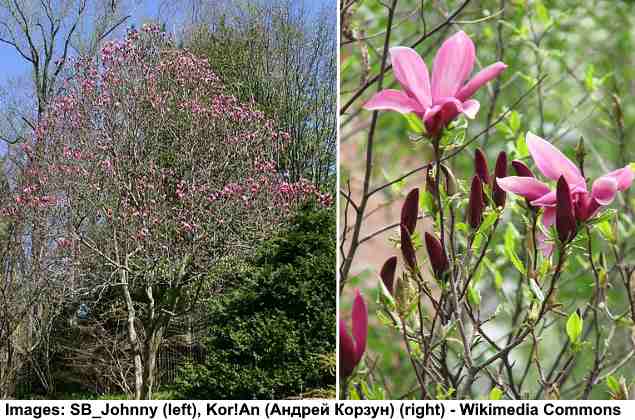
The Susan magnolia is a dwarf tree known for its attractive purple-pinkish flowers that bloom in spring. These fragrant blossoms, bearing a resemblance to tulips, bloom sporadically during the summer months. Every flower displays cup-shaped petals, consisting of six twisted petals measuring 5 inches (13 cm) long. On the outer part of the petals, you’ll find a deep purple shade, contrasting with a paler color on the inner side.
With its dark green, ovate leaves, the magnolia tree forms a stunning contrast to its vibrant flowers. During autumn, the leaves change to a yellow color before falling. The Susan magnolia’s compact size makes it a perfect fit for small gardens, city gardens, or as a focal point in any landscape.
This tree is low maintenance and can tolerate different soil types, yet it prefers well-drained and organically rich soil. To promote optimal growth, it is suggested to provide shelter from cold winds.
Mature Size: 8 to 12 ft. (2.4 – 3.6 m) tall and wide
USDA Hardiness Zones: 3 to 8
Sun: Full sun to partial shade
Angel’s Trumpet (Brugmansia suaveolens)
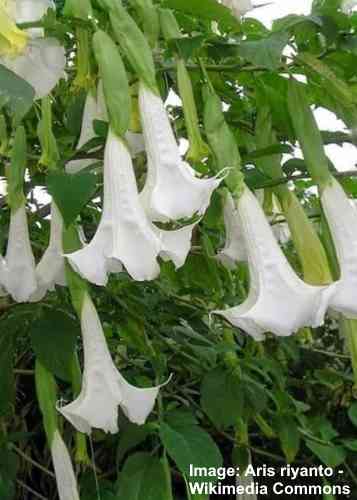
The angel’s trumpet stands out with its attractive, bell-shaped white blooms hanging gracefully from the branches. From summer through fall, this attractive shrub or small tropical tree bursts into a vibrant vase-like display of blossoms. Its mid-green leaves complement the fragrant, creamy-white funnel-shaped flowers that can reach an impressive length of 12 inches (30 cm).
Native to South America, angel’s trumpet prospers in warm and tropical climates. It flourishes when planted in organically rich, fertile soil with good drainage. This exotic tropical tree is perfect for beautifying beds and borders, acting as an eye-catching centerpiece, or adding a tropical touch to patios and decks.
Exercise caution when planting the angel’s trumpet tree in areas frequented by children or pets, as all its parts are toxic if ingested.
Mature Size: 3 to 8 ft. (1 – 2.4 m) tall and 2 to 4 ft. (0.6 – 1 m) wide
USDA Hardiness Zones: 9 to 11
Sun: Full sun or partial shade
Rose Tree (Rosa)

Tree roses are rose shrubs grafted onto a rootstock to create a beautiful, flowering small tree. The long-blooming flowers on tree roses cover a globular growth of dense foliage and thorny branches. One of the advantages of planting tree roses is that you can choose from a multitude of colorful blooms.
In warmer climates, tree roses grow in full sun and thrive in warm weather. It’s best to grow tree roses in large pots in cooler climates where you can over-winter them in a warmer place.
Related articles:


